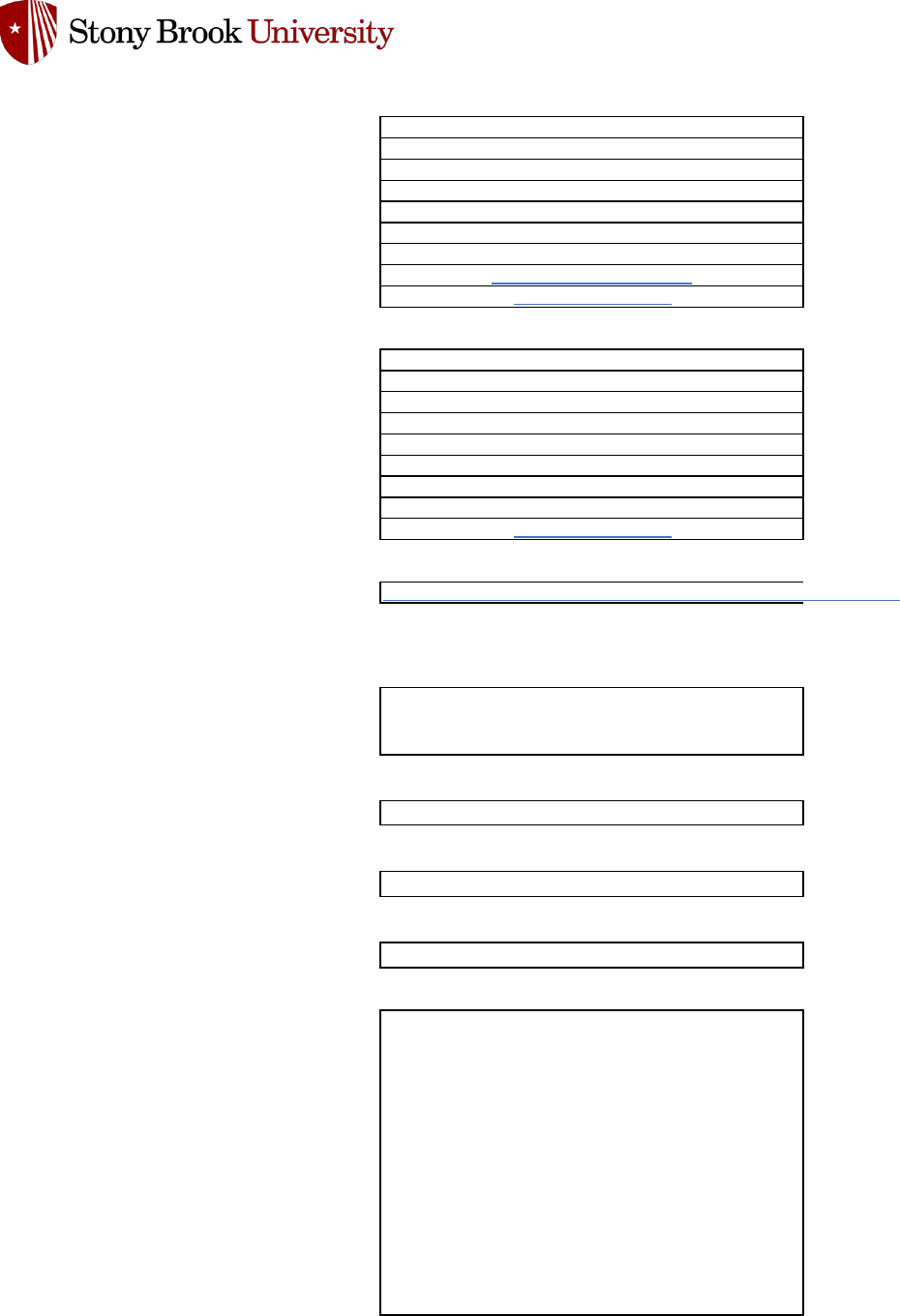
Common Data Set 2023-24
A1. Address Information
Please enter general institution information below:
Name of College or University Stony Brook University
Street Address: Nicolls Road
City: Stony Brook
State: New York
Zip: 11794
Country: United States
Main Institution Phone Number: (631) 689-6000
Main Institution Website: https://www.stonybrook.edu/
Main Institution Email: [email protected]
Please enter Admissions Office information below:
Street Address:
118 Administration Building
City:
Stony Brook
State:
New York
Zip:
11794
Country:
United States
Admissions Phone Number:
(631) 632-6868
Admissions Toll-free Number:
Admissions Website:
Admissions Email Address: [email protected]
Is there a separate URL for your school's online application? If yes, please specify:
https://www.stonybrook.edu/undergraduate-admissions/apply/first-year.php
If you have a mailing address other than the one listed above to which applications should be sent, please provide:
A2. Source of Institutional Control: (click to select from dropdown)
Public
A3. Classify your undergraduate institution: (click to select from dropdown)
Coeducational
A4. Academic year calendar: (click to select from dropdown)
Semester
A4A. Describe if calendar differs by program or other:
Prepared by the Stony Brook University Office of Institutional Research, Planning Effectiveness, November 16, 2023
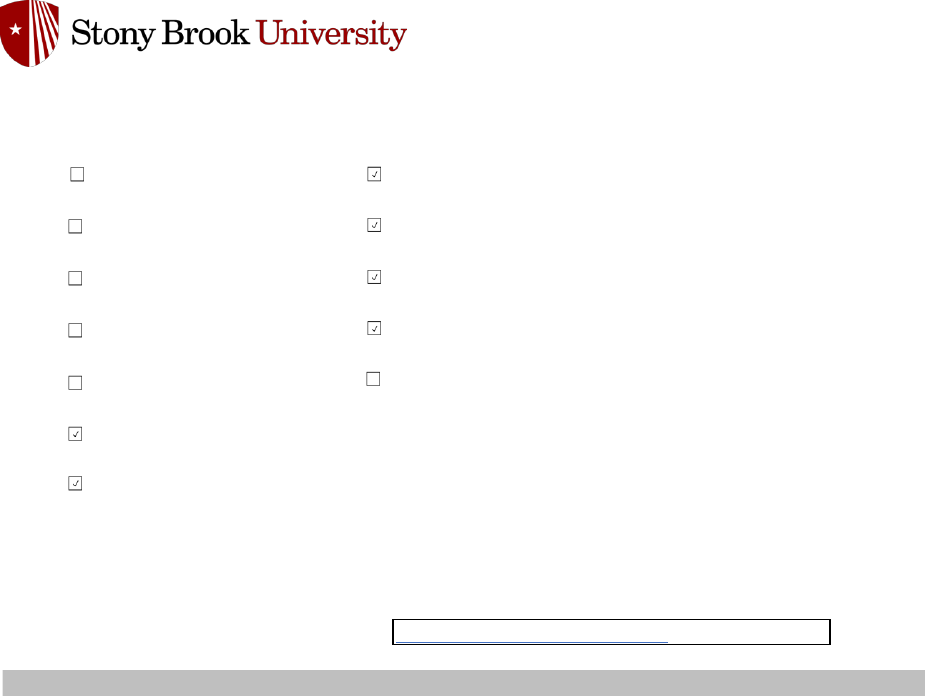
Common Data Set 2023-24
A5. Degrees offered by your institution (select all that apply).
Certificate Master's
Diploma Post-Master's certificate
Associate Doctoral degree - research/scholarship
Terminal Doctoral degree - professional practice
Transfer Doctoral degree - other
Bachelor's
Post-Bachelor's certificate
A6. Diversity, Equity, and Inclusion
If you have a diversity, equity, and inclusion office or department, please provide the URL of the corresponding Web page:
https://www.stonybrook.edu/diversity/
END OF SECTION A
Prepared by the Stony Brook University Office of Institutional Research, Planning Effectiveness, November 16, 2023
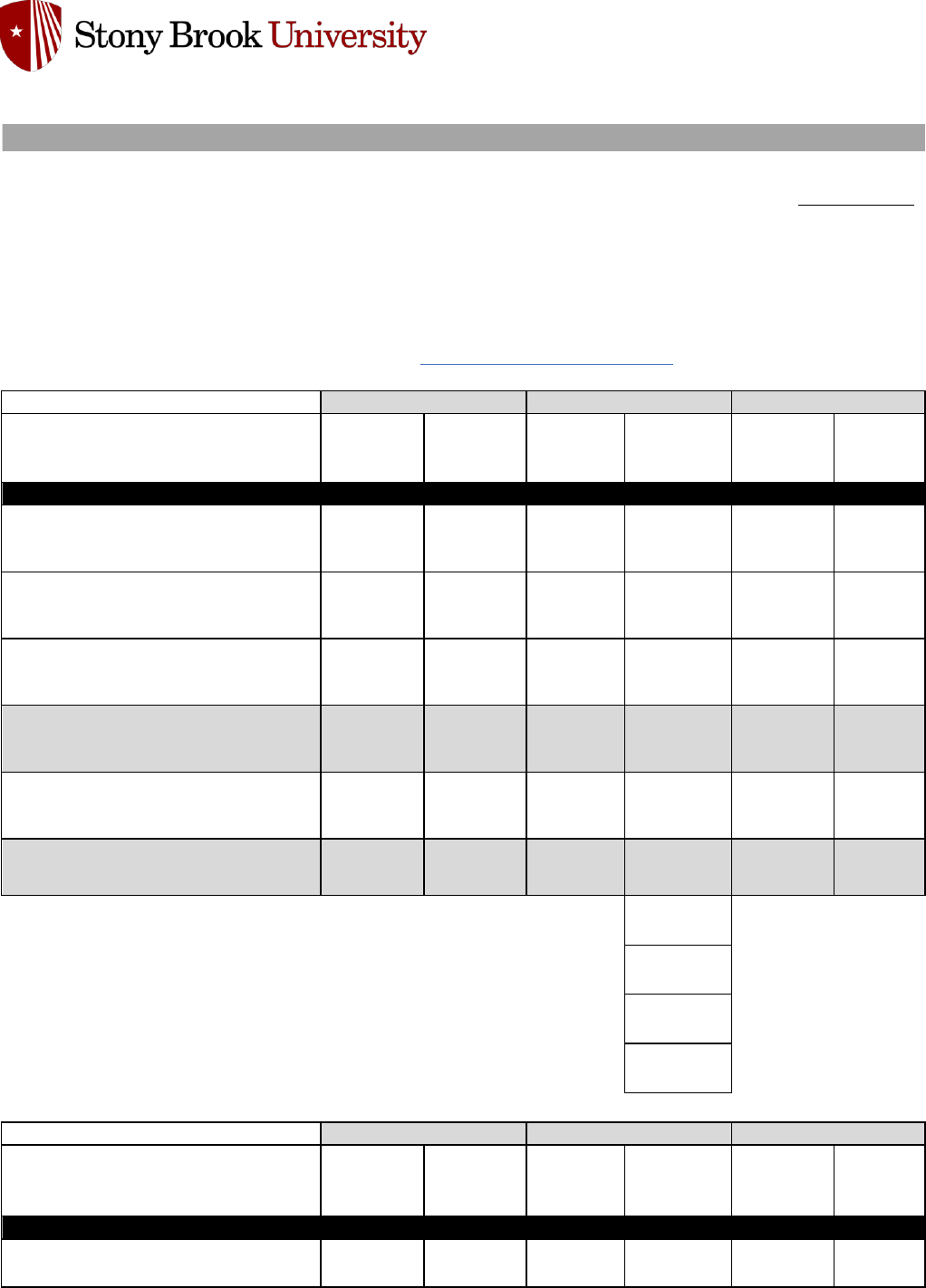
Common Data Set 2023-24
B1. Institutional Enrollment
Full Time
Enrollment
Part Time
Enrollment
Full Time
Enrollment
Part Time
Enrollment
Full Time
Enrollment
Part Time
Enrollment
Degree-seeking, first-time, first-year
students
1,745 1 1,818 5 0 0
Other first-year, degree-seeking students
525 34 680 47 0 0
All other degree-seeking undergraduate
students
5,718 526 5,902 419 0 0
Total degree-seeking undergraduate students
7,988 561 8,400 471 0 0
All other undergraduates enrolled in credit
courses
42 13 63 11 0 0
Total Undergraduate Students
8,030 574 8,463 482 0 0
1,032
16,388
17,420
17,549
Full Time
Enrollment
Part Time
Enrollment
Full Time
Enrollment
Part Time
Enrollment
Full Time
Enrollment
Part Time
Enrollment
Degree-seeking, first-time
887 123 806 349 0 0
B. ENROLLMENT AND PERSISTENCE
For more information on how to report study abroad students, please see NCES.GOV documentation.
GRADUATE STUDENTS
UNDERGRADUATE STUDENTS
Men
Women
Another Gender
Men
Women
Another Gender
Total part-time undergraduate degree-seeking
students
Total full-time undergraduate degree-seeking
students
Total of all undergraduate degree-seeking students
Total of all undergraduate students enrolled
Provide numbers of students for each of the following categories as of the institution’s official fall reporting date or as of October 15, 2023.
1. Report students formaly designated as "first professional" in the graduate counts.
2. If your institution collects and reports non-binary gender data, please use the "Another Gender" category.
In cases where gender information is not provided, please distribute across the two binary categories.
Prepared by the Stony Brook University Office of Institutional Research, Planning Effectiveness, November 16, 2023
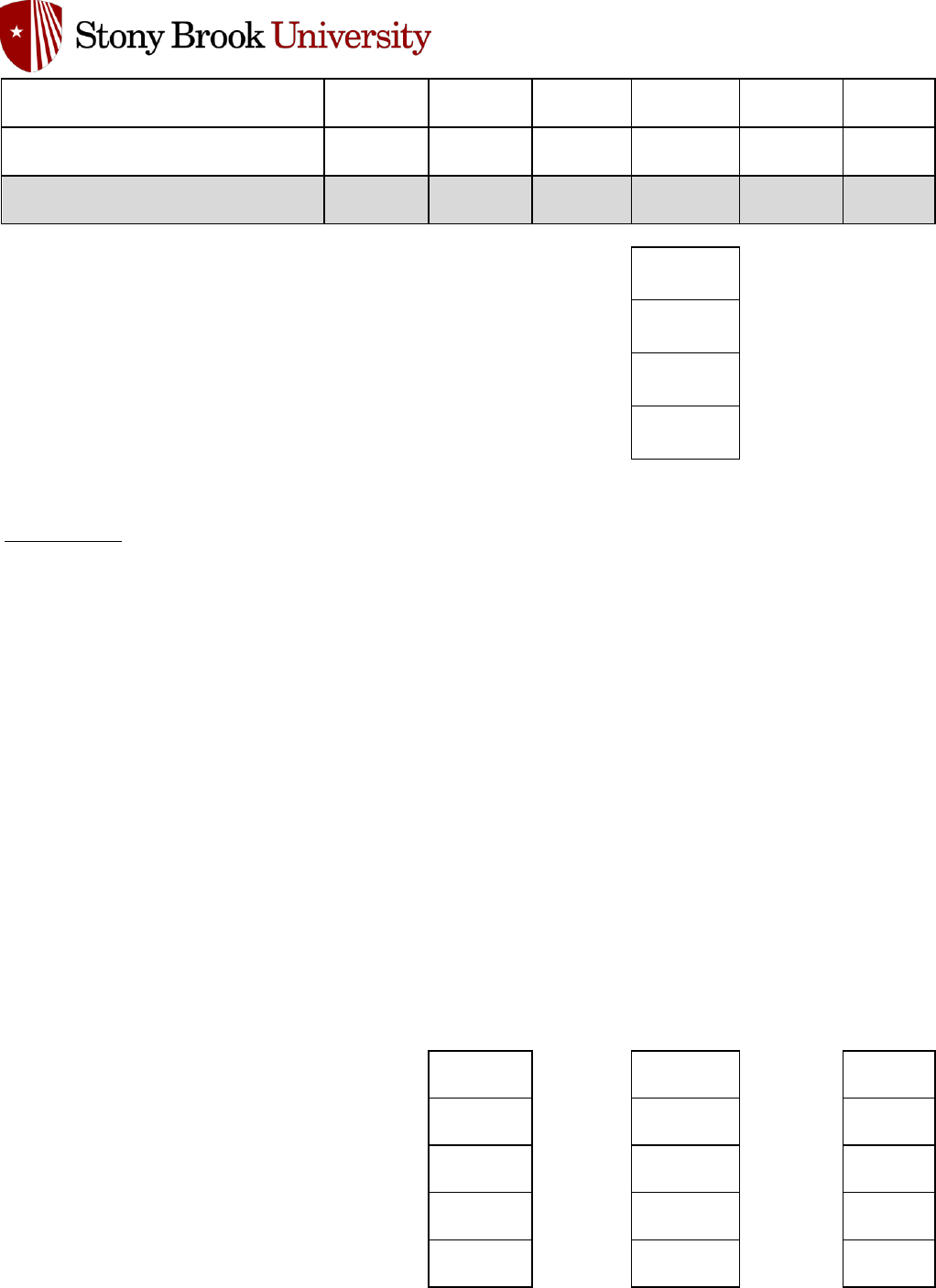
Common Data Set 2023-24
All other degree-seeking
2,002 537 2,012 1,477 0 0
All other graduates enrolled in credit
courses
4 52 6 61 0 0
Total Graduate Students
2,893 712 2,824 1,887 0 0
2,486
5,707
8,193
8,316
B2. Enrollment by Racial/Ethnic Category
International (nonresidents) 259
1,423 1,531
Hispanic/Latino 488
2,670 2,670
Black or African American, non-Hispanic 230
1,052 1,052
White, non-Hispanic 774
4,671 4,673
American Indian or Alaska Native, non-
Hispanic
1
10 10
6. Nonresident – A person who is not a citizen or national of the United States and who is in this country on a student visa or temporary
basis and does not have the right to remain indefinitely. Do not include DACA, undocumented, or other eligible noncitizens in this category.
Nonresidents are to be reported separately, in the boxes provided, rather than included in any of the seven racial/ethnic categories or in
race/ethnicity unknown.
Degree-seeking,
First-time, First-year
Degree-seeking
Undergraduates
(include first-time, first-
year)
Total Undergraduates
(both degree-seeking and
non-degree-seeking)
5. More information about other eligible (for financial aid purposes) non-citizens is available at
https://studentaid.gov/understandaid/eligibility/requirements/non-us-citizens.
1. Include international students only in the category "Nonresidents."
2. Complete the “Total Undergraduates” column only if you cannot provide data for the first two columns.
3. Report as your institution reports to IPEDS: persons who are Hispanic should be reported only on the Hispanic line, not under any race,
and persons who are non-Hispanic multi-racial should be reported only under "Two or more races."
4. New guidance from IPEDS for reporting aggregate data: "Racial/ethnic designations are requested only for United States citizens,
residents, and other eligible non-citizens. Eligible non-citizens include all students who completed high school or a GED equivalency within
the United States (including DACA and undocumented students) and who were not on an F-1 non-immigrant student visa at the time of high
school graduation."
Total part-time graduate degree-seeking students
Total full-time graduate degree-seeking students
Total of all graduate degree-seeking students
Total of all graduate students enrolled
Provide numbers of undergraduate students for each of the following categories as of the institution’s official fall reporting date or as of
October 15, 2023.
Prepared by the Stony Brook University Office of Institutional Research, Planning Effectiveness, November 16, 2023
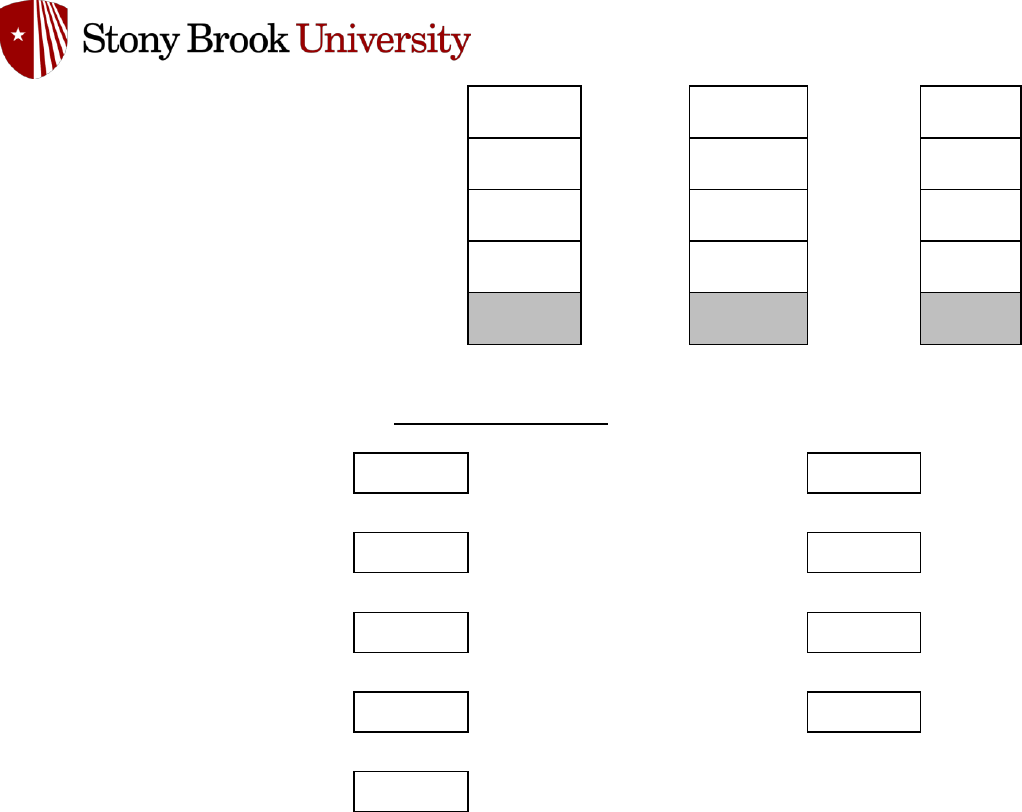
Common Data Set 2023-24
Asian, non-Hispanic 1,555
6,231 6,233
Native Hawaiian or other Pacific Islander,
non-Hispanic
0
8 8
Two or more races, non-Hispanic 114
543 543
Race and/or ethnicity unknown 148
812 829
Total 3,569
17,420 17,549
B3. Persistence / Degrees
Number of degrees awarded by your institution from July 1, 2022, to June 30, 2023.
Certificate/Diploma
Bachelor's Degrees
4,405
139
Master's Degrees
2,263
187
Doctoral degree - research/scholarship
293 269
Doctoral degree - other
Associate's Degrees
Post-Bachelor's Degrees
Post-Master's Degrees
Doctoral degree - professional practice
Prepared by the Stony Brook University Office of Institutional Research, Planning Effectiveness, November 16, 2023
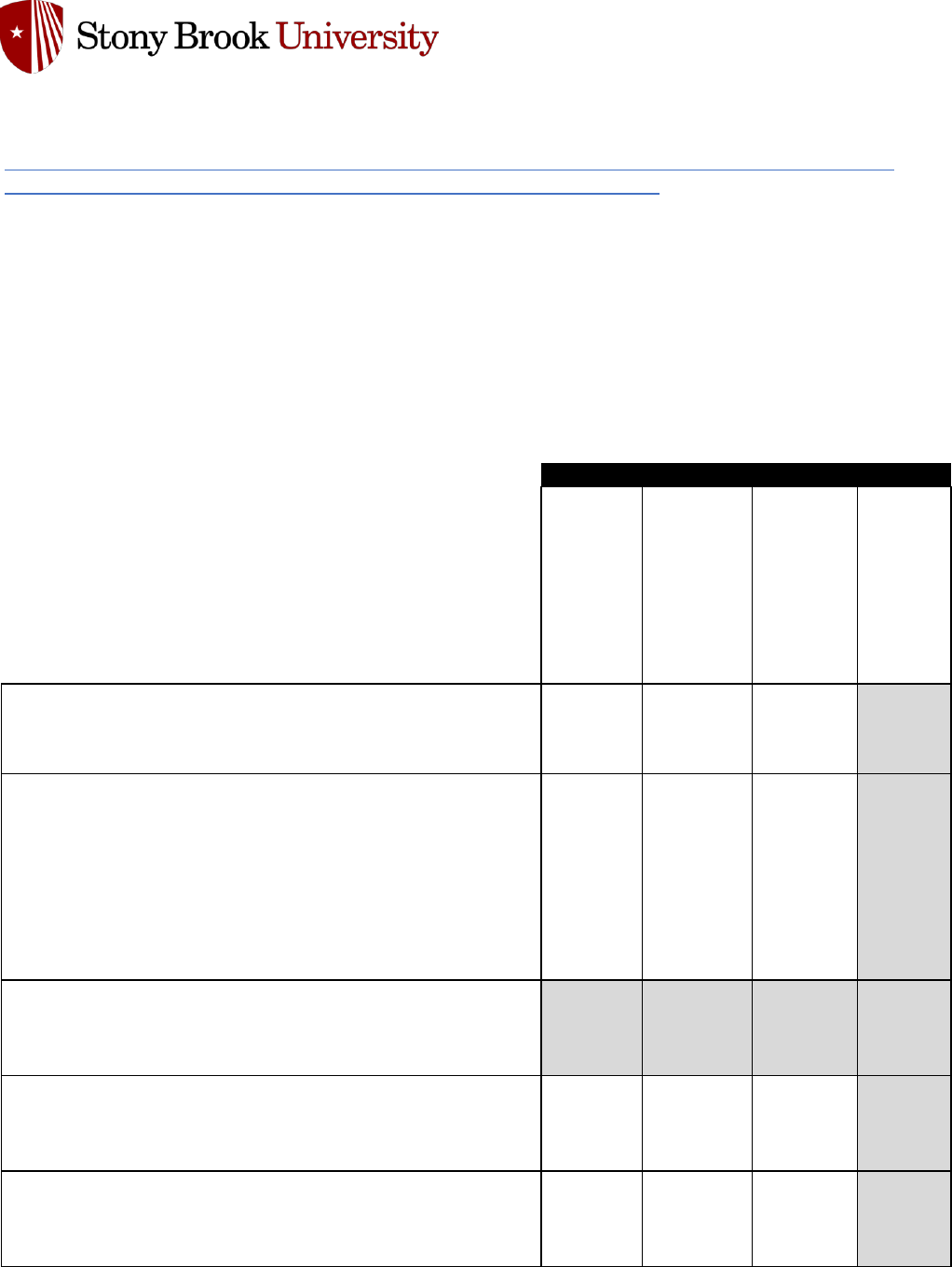
Common Data Set 2023-24
B4 - B21. Graduation Rates
Recipients
of a Federal
Pell Grant
Recipients of
a Subsidized
Stafford
Loan, who
did not
receive a Pell
Grant
Students
who did not
receive
either a Pell
Grant or a
subsidized
Stafford
Loan
Total
1,127 360 1,673 3,160
0 0 0 0
1,127 360 1,673 3,160
758 225 1,116 2,099
117 37 147 301
The items in this section correspond to data elements collected by the IPEDS Web-based Data Collection System’s Graduation
For complete instructions and definitions of data elements, see the IPEDS GRS Forms and Instructions for the 2023-2024
Survey. https://nces.ed.gov/ipeds/use-the-data/survey-components/9/graduation-rates
In the following section for bachelor’s or equivalent programs, please disaggregate the Fall 2016 and Fall 2017 cohorts
(formerly CDS B4-B11) into four groups:
· Students who received a Federal Pell Grant*
· Recipients of a subsidized Stafford Loan who did not receive a Pell Grant
· Students who did not receive either a Pell Grant or a subsidized Stafford Loan
· Total (all students, regardless of Pell Grant or subsized loan status)
* Students who received both a Federal Pell Grant and a subsidized Stafford Loan should be reported in the "Recipients of a
Federal Pell Grant" column.
For Bachelor’s or Equivalent Programs: Please provide data for the Fall
2017 cohort if available. If Fall 2017 cohort data are not available,
provide data for the Fall 2016 cohort.
2017 COHORT (AY - 7)
E. Of the initial 2017 cohort, how many completed the program in
more than four years but in five years or less (after Aug. 31, 2021 and
by Aug. 31, 2022)?
A. Initial 2017 cohort of first-time, full-time, bachelor's (or equivalent)
degree-seeking undergraduate students
B. Of the Initial 2017 cohort, how many did not persist and did not
graduate for any of the following reasons: (report total allowable
exclusions)
- Deceased
- Armed Forces
- Official church mission
- Permanently Disabled
- Foreign Aid Service of the Federal Government
C. Final 2017 cohort, after adjusting for allowable exclusions
D. Of the initial 2017 cohort, how many completed the program in four
years or less (by Aug. 31, 2021)?
Prepared by the Stony Brook University Office of Institutional Research, Planning Effectiveness, November 16, 2023

Common Data Set 2023-24
22 7 31 60
897 269 1,294 2,460
80% 75% 77% 78%
F. Of the initial 2017 cohort, how many completed the program in
more than five years but in six years or less (after Aug. 31, 2022 and by
Aug. 31, 2023)?
G. Total graduating within six years
(Sum of D., E., and F.)
H. Six-year graduation rate for 2017 cohort
(G. divided by C.)
Prepared by the Stony Brook University Office of Institutional Research, Planning Effectiveness, November 16, 2023
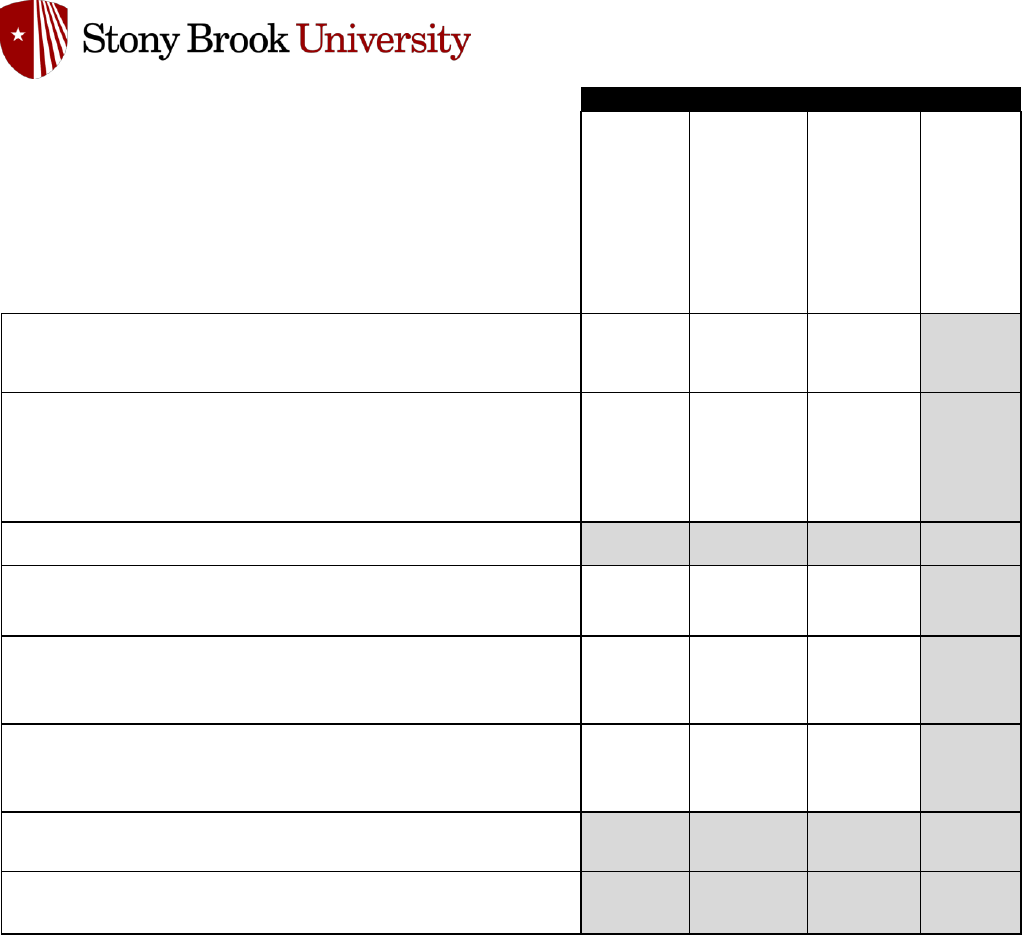
Common Data Set 2023-24
Recipients
of a Federal
Pell Grant
Recipients of
a Subsidized
Stafford
Loan, who
did not
receive a Pell
Grant
Students
who did not
receive
either a Pell
Grant or a
subsidized
Stafford
Loan
Total
1,013 287 1,631 2,931
0 0 0 0
1,013 287 1,631 2,931
660 169 1,076 1,905
119 29 155 303
29 3 39 71
808 201 1,270 2,279
80% 70% 78% 78%
E. Of the initial 2016 cohort, how many completed the program in
more than four years but in five years or less (after Aug. 31, 2020 and
by Aug. 31, 2021)?
2016 COHORT (AY - 8)
A. Initial 2016 cohort of first-time, full-time, bachelor's (or equivalent)
degree-seeking undergraduate students
B. Of the Initial 2016 cohort, how many did not persist and did not
graduate for any of the following reasons: (report total allowable
exclusions)
- Deceased - Permanently Disabled
- Armed Forces - Foreign Aid Service of the Federal Government
- Official church missions
C. Final 2016 cohort, after adjusting for allowable exclusions
D. Of the initial 2016 cohort, how many completed the program in four
years or less (by Aug. 31, 2020)?
F. Of the initial 2016 cohort, how many completed the program in
more than five years but in six years or less (after Aug. 31, 2021 and by
Aug. 31, 2022)?
G. Total graduating within six years
(Sum of D., E., and F.)
H. Six-year graduation rate for 2016 cohort
(G. divided by C.)
For Bachelor’s or Equivalent Programs: Please provide data for the Fall
2017 cohort if available. If Fall 2017 cohort data are not available,
provide data for the Fall 2016 cohort.
Prepared by the Stony Brook University Office of Institutional Research, Planning Effectiveness, November 16, 2023
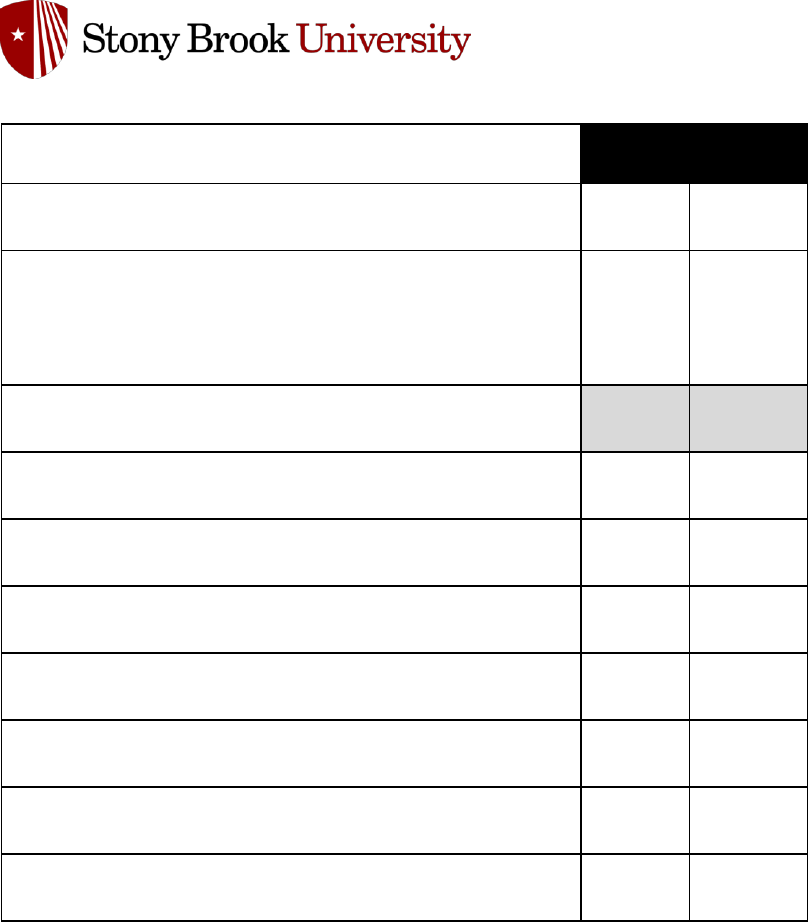
Common Data Set 2023-24
2020 Cohort 2019 Cohort
0.0 0.0
B22. Retention Rates
Report for the cohort of all full-time, first-time bachelor’s (or equivalent) degree-seeking undergraduate students who entered
in Fall 2022 (or the preceding summer term).
The initial cohort may be adjusted for students who departed for the following reasons:
*Death
*Permanent Disability
*Service in the armed forces
*Foreign aid service of the federal government
*Official church missions
*No other adjustments to the initial cohort should be made.
For the cohort of all full-time bachelor’s (or equivalent) degree-seeking undergraduate students who entered your institution as
first-year students in Fall 2022 (or the preceding summer term), what percentage was enrolled at your institution as of the date
your institution calculates its official enrollment in Fall 2023.
Total students retained = students from the Fall 2022 cohort who are still enrolled as of Fall 2023 + students from
Fall 2022 cohort who completed their bachelor’s program as of Fall 2023
(Students from the Fall 2022 cohort still enrolled as of Fall 2023 + Students from Fall 2022 cohort who completed their
bachelor’s program as of Fall 2023)/(Adjusted Fall 2022 cohort) *100
Note: The number of first-time students seeking a bachelor’s degree (or equivalent) who attain a bachelor’s degree (or
equivalent) by their second fall term is expected to be zero or very small. In exceptional cases when a first-time student does
satisfy all degree requirements including full credit completion (e.g., typically 120 credit hours) and is awarded a bachelor’s
degree (or equivalent) by their second fall term, they are to be considered “retained” for EF reporting purposes.
B18. Completers of programs of at least two but less than four-years within
150 percent of normal time:
B19. Total transfers-out (within three years) to other institutions:
B20. Total transfers to two-year institutions:
B21. Total transfers to four-year institutions:
B15. Completers of programs of less than two years duration (total):
B16. Completers of programs of less than two years within 150 percent of
normal time:
B17. Completers of programs of at least two but less than four years (total):
Please provide data for the 2020 cohort if available. If 2020 cohort data are
not available, provide data for the 2019 cohort.
Two-Year Institutions - Graduation, Completion Counts
B12. Initial cohort, total of first-time, full-time degree/certificate-seeking
students:
B13. Of the initial cohort, how many did not persist and did not graduate for
any of the following reasons: (report total allowable exclusions)
- Deceased - Permanently Disabled
- Armed Forces - Foreign Aid Service of the Federal Government
- Official church missions
B14. Final cohort, after adjusting for allowable exclusions:
Prepared by the Stony Brook University Office of Institutional Research, Planning Effectiveness, November 16, 2023

Common Data Set 2023-24
Enter retention rate: 89%
Report for the cohort of all full-time, first-time bachelor’s (or equivalent) degree-seeking undergraduate students who entered
in Fall 2022 (or the preceding summer term).
The initial cohort may be adjusted for students who departed for the following reasons:
*Death
*Permanent Disability
*Service in the armed forces
*Foreign aid service of the federal government
*Official church missions
*No other adjustments to the initial cohort should be made.
For the cohort of all full-time bachelor’s (or equivalent) degree-seeking undergraduate students who entered your institution as
first-year students in Fall 2022 (or the preceding summer term), what percentage was enrolled at your institution as of the date
your institution calculates its official enrollment in Fall 2023.
Total students retained = students from the Fall 2022 cohort who are still enrolled as of Fall 2023 + students from
Fall 2022 cohort who completed their bachelor’s program as of Fall 2023
(Students from the Fall 2022 cohort still enrolled as of Fall 2023 + Students from Fall 2022 cohort who completed their
bachelor’s program as of Fall 2023)/(Adjusted Fall 2022 cohort) *100
Note: The number of first-time students seeking a bachelor’s degree (or equivalent) who attain a bachelor’s degree (or
equivalent) by their second fall term is expected to be zero or very small. In exceptional cases when a first-time student does
satisfy all degree requirements including full credit completion (e.g., typically 120 credit hours) and is awarded a bachelor’s
degree (or equivalent) by their second fall term, they are to be considered “retained” for EF reporting purposes.
END OF SECTION B
Prepared by the Stony Brook University Office of Institutional Research, Planning Effectiveness, November 16, 2023
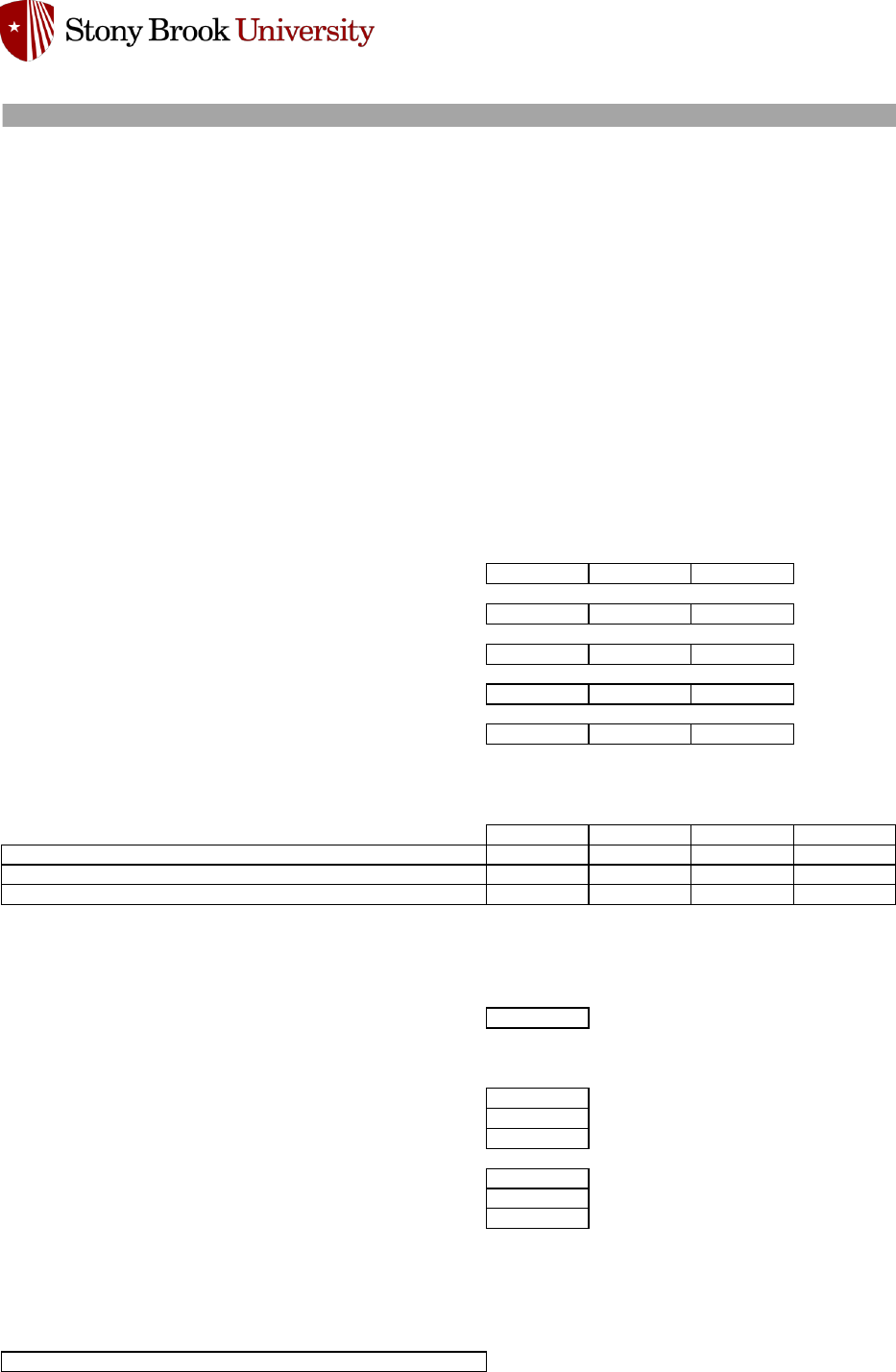
Common Data Set 2023-24
C1. Applications: First-time, First-year Students
Men Women
Another
Gender
Total first-time, first-year students who applied in Fall 2023
22,956 27,368 17
Total first-time, first-year students admitted in Fall 2023
10,593 14,066 11
Total first-time, first-year students enrolled in Fall 2023
1,746 1,823 0
Full-time, first-time, first-year students enrolled in Fall 2023
1,745 1,818 0
Part-time, first-time, first-year students enrolled in Fall 2023
1 5 0
In-State Out-of-State International Total
Total first-time, first-year (degree seeking) who applied
35,794 9,442 5,105 50,341
Total first-time, first-year (degree seeking) who were admitted
15,303 5,722 3,645 24,670
Total first-time, first-year (degree seeking) enrolled
2,956 354 259
3,569
C2. Applications: First-time, First-year Wait-Listed Students
Students who met admission requirements but whose final admission was contingent on space availablity.
Do you have a policy of placing students on a waiting list?
Yes
Select from the dropdown menu.
If yes, please answer the questions below for Fall 2023 admissions:
Number of qualified applicants offered a place on waiting list:
3,647
Number accepting a place on the waiting list:
1,793
Number of wait-listed students admitted:
1,577
Is your waiting list ranked? No
If yes, do you release that information to students? No
If yes, do you release that information to school counselors?
C3. Admission Requirements: High School Completion Requirement
Does your institution require high school completion for degree-seeking entering students? Select from dropdown.
High school diploma is required and GED is accepted
C. FIRST-TIME, FIRST-YEAR ADMISSION
Provide the number of degree-seeking, first-time, first-year students who applied, were admitted, and enrolled (full- or part-time) in Fall 2023.
- Include early decision, early action, and students who began studies during summer in this cohort.
- Applicants should include only those students who fulfilled the requirements for consideration for admission (i.e., who completed actionable
applications) and who have been notified of one of the following actions: admission, non-admission, placement on waiting list, or application
withdrawn (by applicant or institution).
- Admitted applicants should include wait-listed students who were subsequently offered admission.
- Since the total may include students who did not provide gender data, the detail need not sum to the total.
- If your institution collects and reports non-binary gender data, please use the “Another Gender” category.
- Note that recent high school graduates and other students without prior postsecondary experience will still be considered “first-time
students” for fall enrollment reporting purposes even if they enrolled in the summer prior to fall enrollment.
Prepared by the Stony Brook University Office of Institutional Research, Planning Effectiveness, November 16, 2023
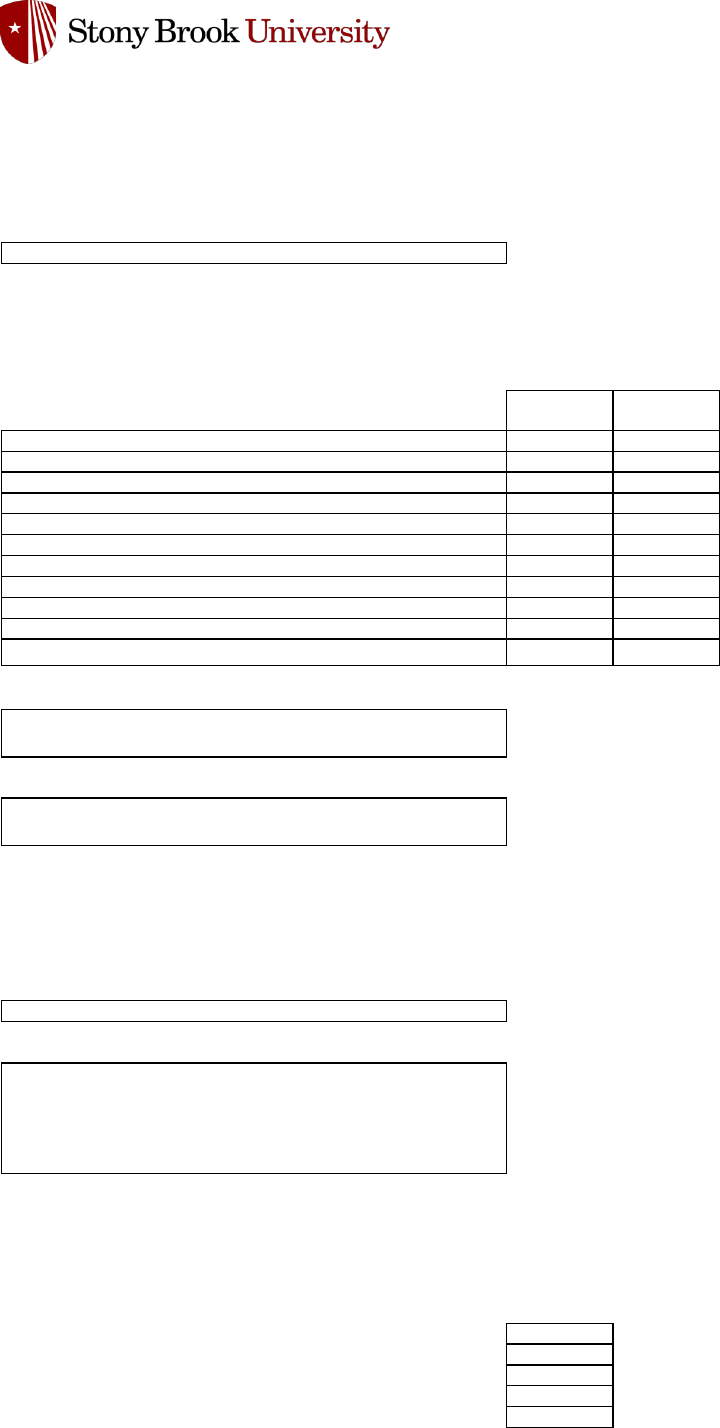
Common Data Set 2023-24
C4. Admission Requirements: General College-Prepatory Program
Recommend
C5. Admission Requirements: High School Units Required/Recommended
Units
Required
Units
Recommended
Total Academic Units 14.0 19.0
English 4.0 4.0
Mathematics 3.0 4.0
Science 3.0 4.0
of Science Units, how many units must be lab
Foreign language 3.0
Social Studies 4.0 4.0
History
Computer Science
Visual/Performing Arts
Academic Electives
Other Elective Units required (please specify):
Other Elective Units recommended (please specify):
C6. Basis for Selection: Open Admission Policy
If "Other" is selected, please include detail in the textbox below:
C7. Basis for Selection: Relative Importance of Factors in Admission Decisions
ACADEMIC
Rigor of secondary school record
Very Important
Class rank
Considered
Academic Grade Point Average (GPA)
Recommendations
Important
Standardized test scores
Very Important
Please indicate the relative importance of each of the following academic and non-academic factors in your first-time, first-year degree-
seeking general admission decisions (not including programs with specific criteria): select from the dropdown menus.
Does your institution require OR recommend a general college-preparatory program for degree-seeking students? Select from dropdown.
Specify the distribution of academic high school course unites required and/or recommend of all or most degree-seeking students using
Carnegie units (one unit equals one year of study or its equivalent). If you use a different system, please convert to Carnegie.
Does your institution have an open admission policy, under which virtually all secondary school graduates or
students with GED equivalency diplomas are admitted without regard to academic record, test scores, or
other qualifications? Select the most applicable response from the dropdown options.
Prepared by the Stony Brook University Office of Institutional Research, Planning Effectiveness, November 16, 2023
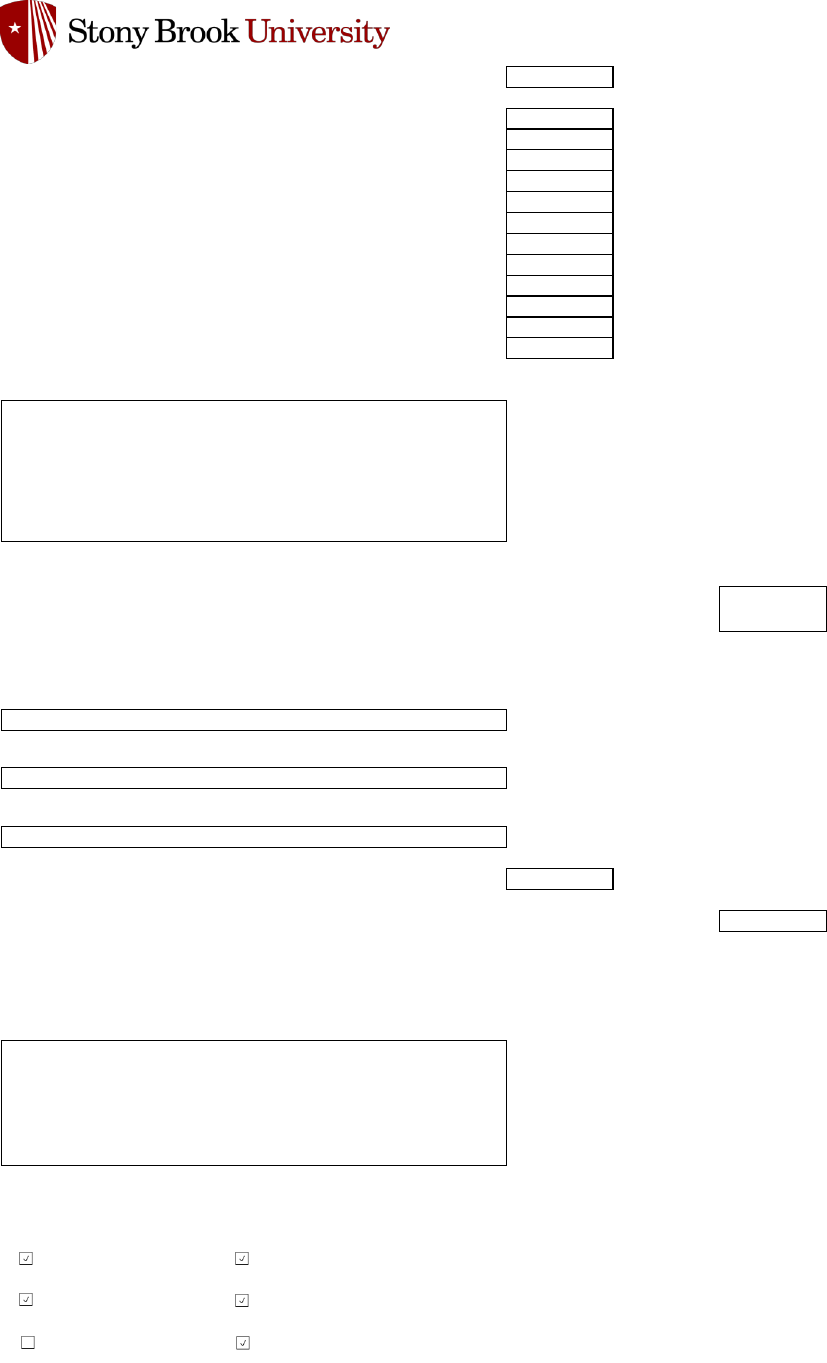
Common Data Set 2023-24
Application essay
Very Important
NONACADEMIC
Interview
Considered
Extracurriculuar activities
Considered
Talent/ability
Considered
Character/personal qualities
Considered
First generation
Considered
Alumni/ae relation
Considered
Geographical residence
Considered
State residency
Considered
Religious affilitation/commitment
Not Considered
Volunteer work
Considered
Work experience
Considered
Level of applicant's interest
Considered
Please provide additional information if the importance of any specific academic or nonacademic factors differ by academic program:
C8. SAT and ACT Policies
Yes
If yes, please select the appropriate response from the dropdown menus for each possible option below for admission for Fall 2025.
SAT and/or ACT
Not required for admission, but considered for some
ACT Only
SAT Only
Does your institution use applicants' test scores for academic advising?
No
What is the latest date by which SAT or ACT scores must be received for fall-term admission?
2/1/2024
Please use the following format: MM/DD/YYYY
Please indicate which tests your institution uses for placement
(e.g. state tests):
If you selected State Exam, please specify:
If necessary, please use this space to clarify your test policies (e.g., if tests are recommended for some students, or if tests are not required of
some students due to differences by academic program, student academic background, or if other examinations may be considered in lieu of
the SAT and ACT.)
Does your institution make use of SAT or ACT scores in admissions decisions for first-time, first-
year, degree-seeking applicants?
SAT
ACT
AP
CLEP
Institutional Exam
State Exam
Prepared by the Stony Brook University Office of Institutional Research, Planning Effectiveness, November 16, 2023

Common Data Set 2023-24
NYS Regents Exams
Prepared by the Stony Brook University Office of Institutional Research, Planning Effectiveness, November 16, 2023
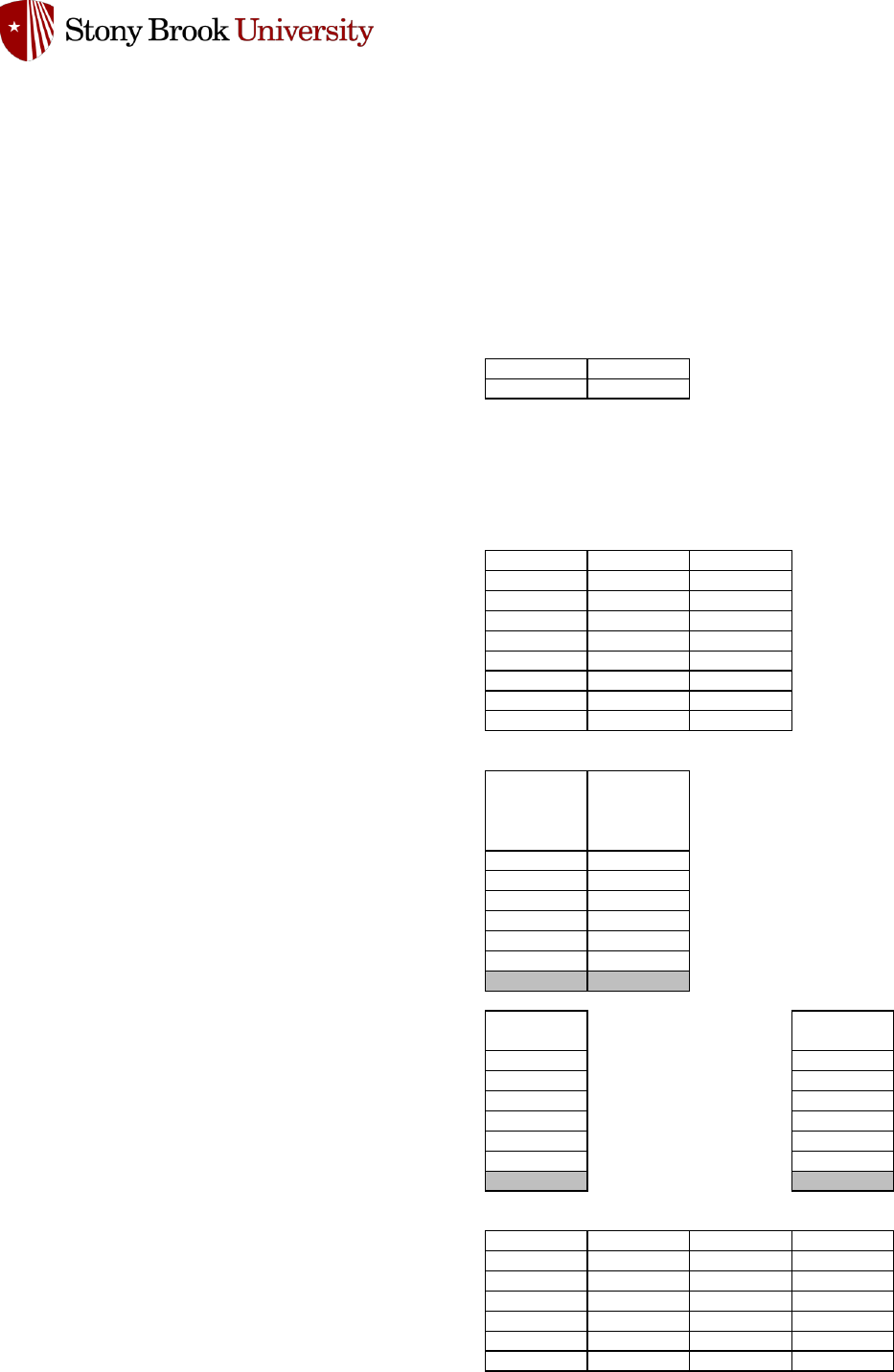
Common Data Set 2023-24
C9. First-time, first-year profile: National standardized test scores (SAT/ACT)
3. Do not convert SAT scores to ACT scores and vice versa.
Percent Number
Submitting SAT Scores 36% 1,285
Submitting ACT Scores 3% 106
Assessment
25th
Percentile
Score
50th
Percentile
Score
(not used in
BFCP)
75th
Percentile
Score
SAT Composite (400 - 1600)
1330 1400 1470
SAT Evidence-Based Reading and Writing (200 - 800)
640 680 720
SAT Math (200 - 800)
680 730 770
ACT Composite (0 - 36)
28 31 33
ACT Math (0 - 36)
27 30 33
ACT English (0 - 36)
27 32 34
ACT Reading (0 - 36)
30 33 35
ACT Science (0 - 36)
27 32 34
ACT Writing (0 - 36)
Percent of first-time, first-year students with scores in each range:
Sum of each column should equal 100%.
Score Range
SAT Evidence-
Based Reading
and Writing
SAT Math
700-800 42.26% 67.08%
600-699 50.74% 29.42%
500-599 6.84% 3.35%
400-499 0.16% 0.15%
300-399
200-299
Total
100% 100%
Score Range
SAT
Composite
Score Range
ACT
Composite
1400-1600 53.40% 30 - 36 64.20%
1200-1399 44.50% 24 - 29 33.00%
1000-1199 2.00% 18 - 23 2.80%
800-999 0.10% 12 - 17
600-799 6 - 11
400-599 Below 6
Total
100%
Total
100%
Score Range
ACT English ACT Math ACT Reading ACT Science
30 - 36 61.90% 56.20% 75.20% 62.90%
24 - 29 32.40% 35.20% 19.00% 33.30%
18 - 23 5.70% 7.60% 4.80% 3.80%
12 - 17 1.00% 1.00%
6 - 11
Below 6
4. If a student submitted multiple sets of scores for a single test, report this information according to how you use the data.
For example: If you consider the highest scores from either submission, use the highest combination of scores (e.g., verbal from one
submission, math from the other). If you average the scores, use the average to report the scores.
For each assessment listed below, report the score that represents the 25th percentile (the score that 25 percent of the first-time,
first-year population scored at or below) and the 75th percentile score (the score that 25 percent scored at or above).
Provide information for all enrolled, degree-seeking, full-time and part-time, first-time, first-year students enrolled in Fall 2023, including
students who began studies during summer, international students/nonresidents, and students admitted under special arrangements. Report
the percent and number of first-time, first-year students enrolled in Fall 2023 who submitted national standardized (SAT/ACT) test scores.
1. Include information for ALL enrolled, degree-seeking, first-time, first-year students who submitted test scores.
2. Do not include partial test scores (e.g., mathematics scores but not critical reading for a category of students) or combine other
Prepared by the Stony Brook University Office of Institutional Research, Planning Effectiveness, November 16, 2023
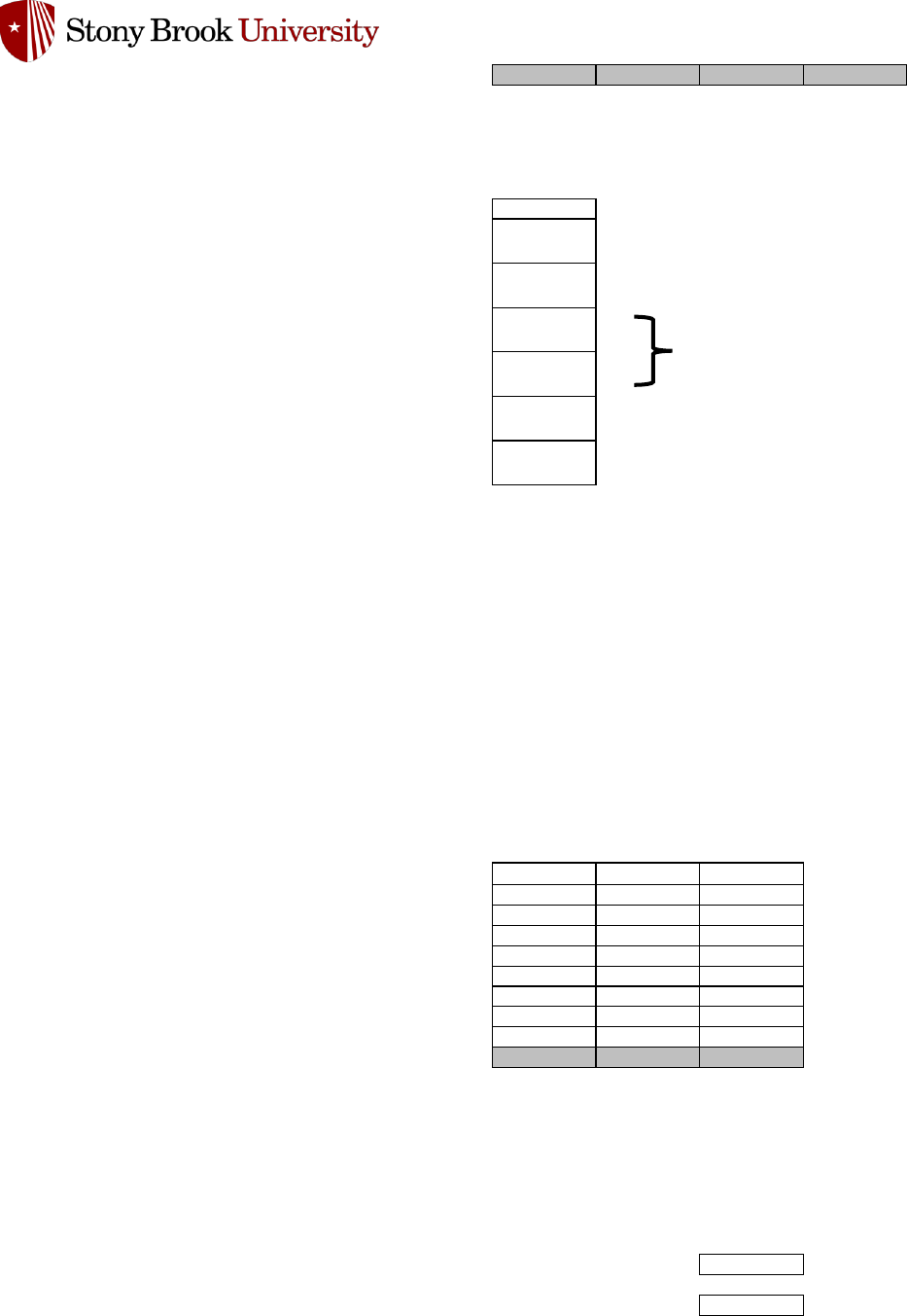
Common Data Set 2023-24
Total
100% 100% 100% 100%
C10. Class Rank Ranges
Class Rank Range Percent
Percent in top tenth of high school graduating class
50.5%
Percent in top quarter of high school graduating class
83.7%
Percent in top half of high school graduating class
97.4%
Percent in bottom half of high school graduating class
2.6%
Percent in bottom quarter of high school graduating class
0.0%
Percent of total first-time, first-year students who submitted high school
class rank
29.0%
C11. High School Grade Point Ranges
Score Range
Percent of
students who
submitted
scores
Percent of
students who
did not submit
scores
Percent of all
enrolled
students
Percent who had GPA of 4.0
40.94% 26.64% 32.95%
Percent who had GPA between 3.75 and 3.99
32.11% 31.81% 31.94%
Percent who had GPA between 3.50 and 3.74
19.58% 21.83% 20.84%
Percent who had GPA between 3.25 and 3.49
5.21% 11.44% 8.69%
Percent who had GPA between 3.00 and 3.24
1.84% 7.93% 5.24%
Percent who had GPA between 2.50 and 2.99
0.26% 0.30% 0.28%
Percent who had GPA between 2.0 and 2.49
0.06% 0.05% 0.06%
Percent who had GPA between 1.0 and 1.99
0.00% 0.00% 0.00%
Percent who had GPA below 1.0
0.00% 0.00% 0.00%
Total
100.0% 100.0% 100.0%
C12. Average High School GPA
Average high school GPA of all degree-seeking, first-time, first-year students who submitted GPA:
93.52
Percent of total first-time, first-year students who submitted high school GPA: 99.92%
2. If you are able to report GPA ranges separately for students that also submitted at least one test score versus those who did not
submit a test score, please do so in the respective columns. If you are unable to report these data, please report the ranges for all
students.
Percent of all degree-seeking, first-time, first-year students who had high school class rank within each of the following ranges (report
information for those students from whom you collected high school rank information).
Top half and bottom half
should = 100%.
Percentage of all enrolled, degree-seeking, first-time, first-year students who had high school grade-point averages within each of the
following ranges (using 4.0 scale).
1. Report information only for those students from whom you collected high school GPA.
Percent of all enrolled students was previously collected. Reporting by submitted test score is new. If available, please report
all three segments of students.
Prepared by the Stony Brook University Office of Institutional Research, Planning Effectiveness, November 16, 2023
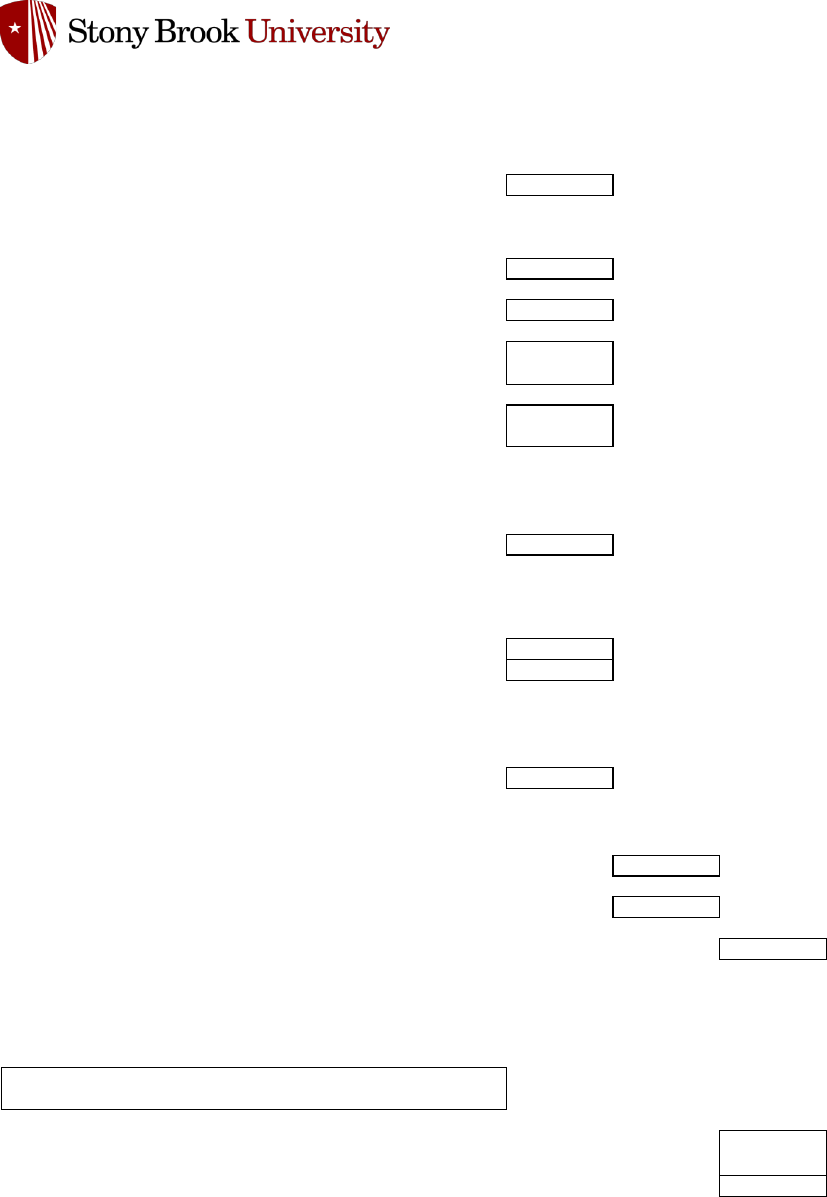
Common Data Set 2023-24
C13. Application Fee
Does your institution have an application fee? Yes
If your institution has waived its application fee for the Fall 2025 application
cycle, please select no.
If yes, what is the amount of the application fee: $50.00
If yes, can the fee be waived for applicants with financial need? Yes
If you have an application fee, and have an online application
option, please indicate the policy for students who apply online:
Same Fee
If you have an application fee for online applications, can the fee be
waived for students with financial need?
Yes
C14. Application Closing Date
Does your institution have an application closing date? Yes
If yes, please enter the dates below:
Please use the following format: (MM/DD)
Application Closing Date (Fall) 1/15
Priority Date 1/15
C15. First-time, first-year student acceptance other than Fall
Are first-time, first-year students accepted for terms other than the Fall? Yes
C16. Admissions Notification to Applicants
Are notifications to applicants of admission decision sent on a rolling basis?
Yes
What date do rolling notifications begin? (MM/DD)
If notifications of admission decision are sent by specific date, please enter date: (MM/DD) 4/1
C17. Reply Policy for Applicants
What is your institution's reply policy for admitted applicants? (select from dropdown menu and related follow-up textbox)
Must reply by May 1st (or within set number of weeks if notified thereafter)
2
Please provide admitted applicant policy, if none of the above policies apply to your institution:
If you selected reply by May 1st or within a set number of weeks, please enter number of weeks:
If you selected specific date, please enter the date here: (MM/DD)
Prepared by the Stony Brook University Office of Institutional Research, Planning Effectiveness, November 16, 2023
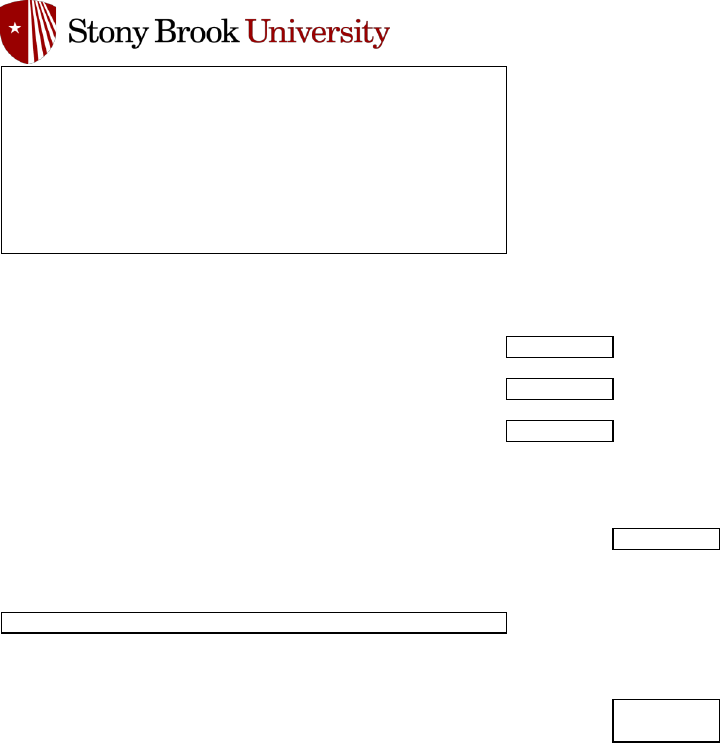
Common Data Set 2023-24
Deadline for housing deposits: (MM/DD)
5/1
Amount of housing deposit: $200.00
Are housing deposits refundable if student does not enroll? Yes, in part
C18. Deferred Admission
Does your institution allow students to postpone enrollment after admission? Yes
If yes, what is the maximum period of postponement?
1 year
C19. Early Admissions
No
C20. Common Application (Questions Removed from CDS.)
Does your institution allow high school students to enroll as full-time,
first-time, first-year students one year or more before high school graduation?
Prepared by the Stony Brook University Office of Institutional Research, Planning Effectiveness, November 16, 2023
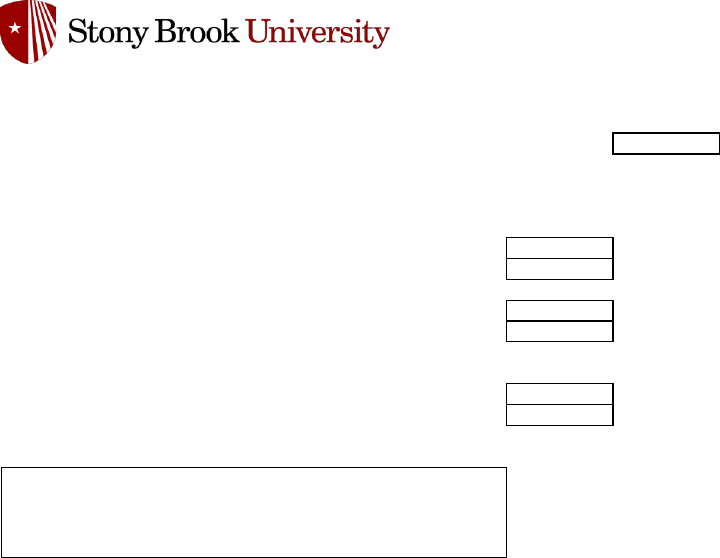
Common Data Set 2023-24
C21. Early Decision
No
If yes, please complete the following applicable dates:
First or only early decision plan closing date:
First or only early decision plan notification date:
Other early decision plan closing date:
Other early decision plan notification date:
For the Fall 2023 entering class:
Number of early decision applications received by your institution:
Number of applicants admitted under early decision plan:
Please provide significant details about your early decision plan:
Does your institution offer an early decision plan (an admission plan that permits students to
apply and be notified of an admission decision well in advance of the regular notification
date and that asks students to commit to attending if accepted) for first-time, first-year
applicants for fall enrollment?
Prepared by the Stony Brook University Office of Institutional Research, Planning Effectiveness, November 16, 2023
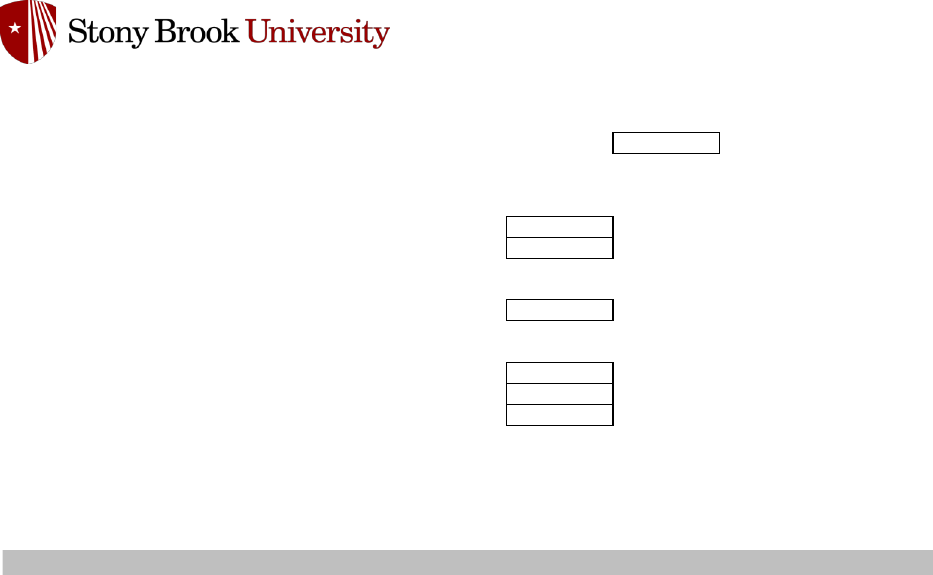
Common Data Set 2023-24
C22. Early Action
Yes
If yes, please complete the following: (MM/DD)
Early action closing date: 10/15
Early action notification date: 1/31
No
For the Fall 2023 entering class:
Number of early action applications received by your institution:
Number of applicants admitted under early action plan:
Number of applicants enrolled under early action plan:
Do you have a nonbinding early action plan whereby students are notified of an admission
decision well in advance of the regular notification date but do not have to commit to
attending your college?
Is your early action plan a "restrictive" plan under which you limit students
from applying to other early plans?
END OF SECTION C
Prepared by the Stony Brook University Office of Institutional Research, Planning Effectiveness, November 16, 2023
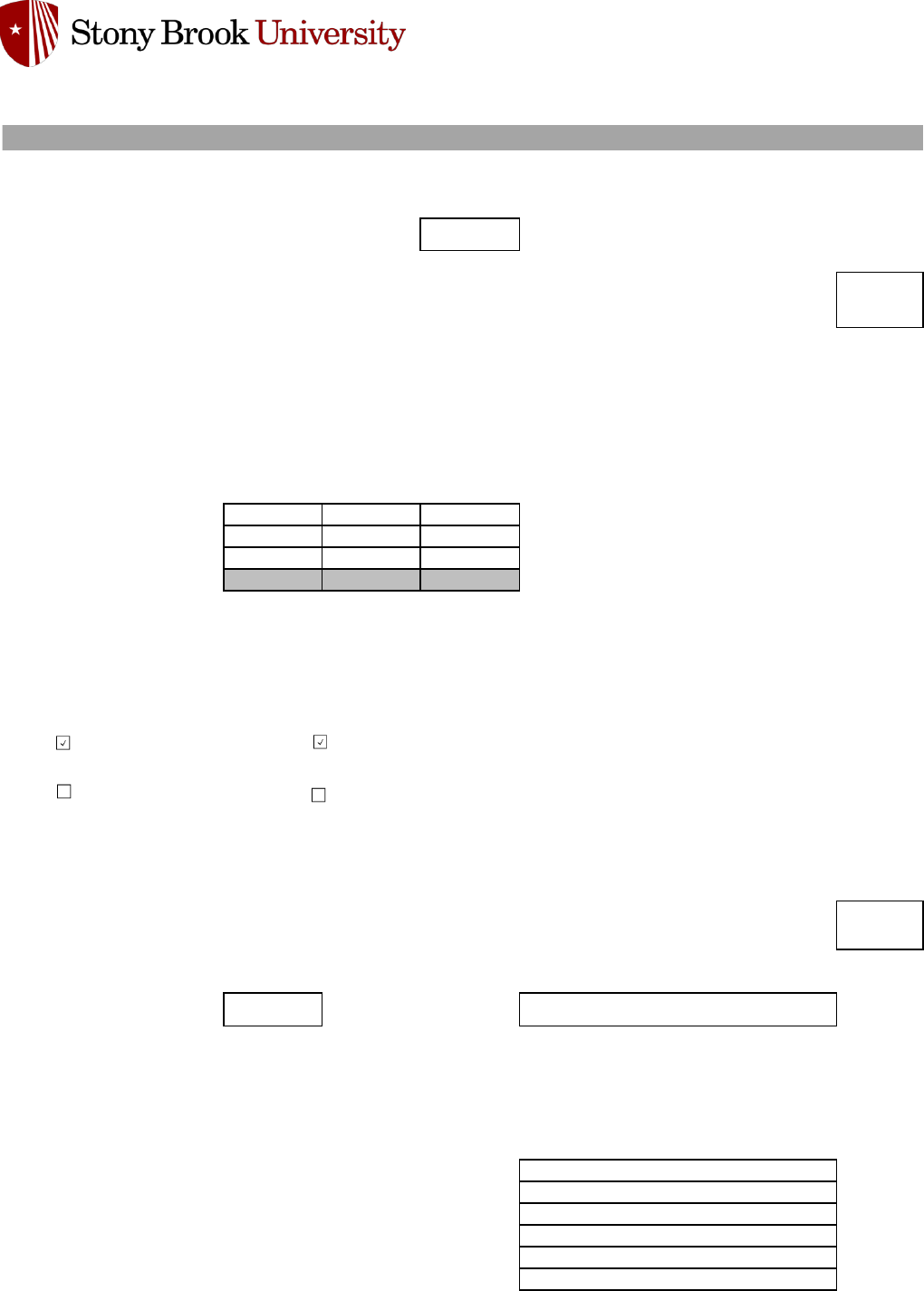
Common Data Set 2023-24
D1. Fall Applicants: Transfer Student Enrollment
Does your institution enroll transfer students?
Yes
Yes
D2. Fall Applicants: Student Counts
Applicants
Admitted
Applicants
Enrolled
Applicants
Men 2812 1211 559
Women 2812 1475 727
Another Gender 1 1 0
Total 5625 2687 1286
Common Data Set 2023-2024
D3. Enrollment Terms
Please indicate which terms for which transfer students may enroll: (select all that apply)
D4. Transfer Applicants Minimum Credits
No
If yes, what is the minimum number and the unit type?
Number:
Unit Type:
D5. Requirements for Admission
Please indicate if the below items are required, recommended, or not of transfer students to apply for admission:
Select from the dropdown menu.
Required of Some
Required of All
Not Required
Not Required
Required of Some
Not Required
Provide the number of students who applied, were admitted, and enrolled as degree-seeking transfer students in Fall 2023.
If your institution collects and reports non-binary gender data, please use the "Another Gender" category.
Essay or personal statement
Interview
Standardardized test scores
Statement of good standing from prior institution(s)
Must a transfer applicant have a minimum number of credits/courses completed
or else must apply as an entering first-year student?
High school transcript
College transcript(s)
If yes, may transfer students earn advanced standing credit by transferring credits earned from course work completed at
other colleges/universities?
D. TRANSFER ADMISSION
Fall
Winter
Spring
Summer
Prepared by the Stony Brook University Office of Institutional Research, Planning Effectiveness, November 16, 2023
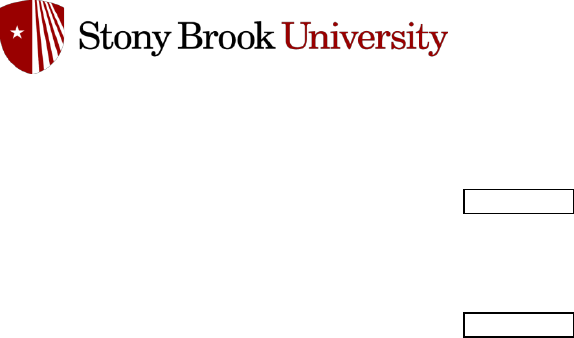
Common Data Set 2023-24
D6. Minimum High School GPA Required
If a minimum high school grade point average is required of transfer applicants, specificy (on a 4.0) scale:
D7. Minimum College GPA Required
If a minimum college grade point average is required of transfer applicants, specificy (on a 4.0) scale:
2.8
GPA Required:
GPA Required:
Prepared by the Stony Brook University Office of Institutional Research, Planning Effectiveness, November 16, 2023
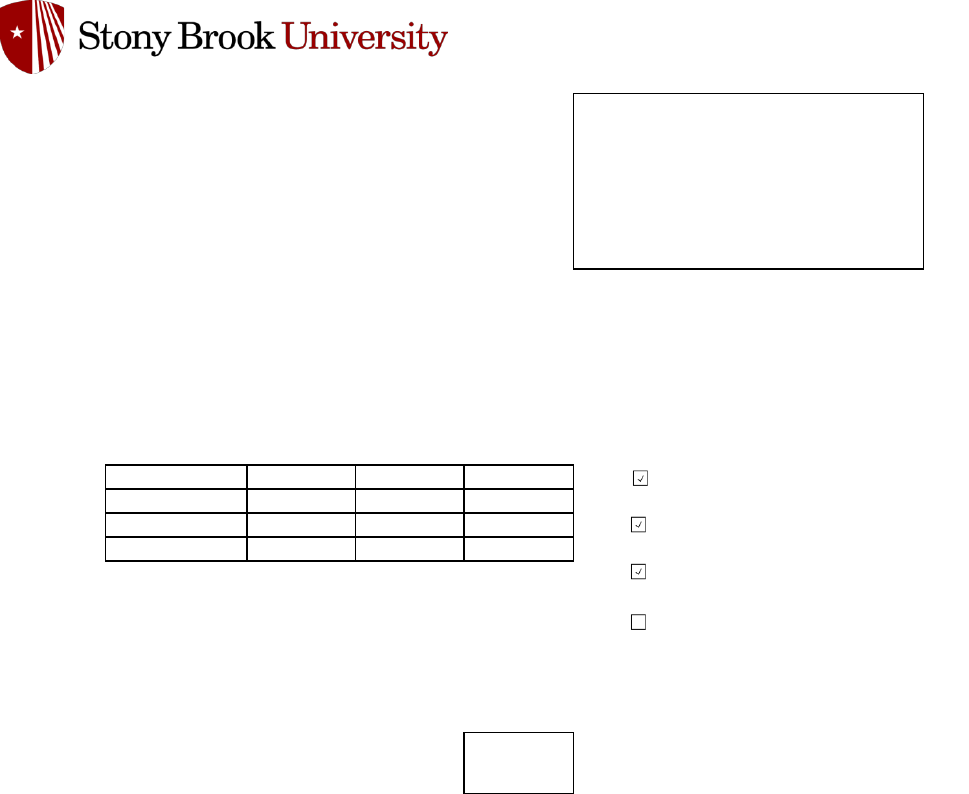
Common Data Set 2023-24
D8. List any other application requirements specific to transfer applicants:
D9. Application Specific Dates
Priority Date Closing Date
Notification
Date
Reply Date Rolling Admission
Fall 3/1
Winter
Spring 11/1
Summer
D10. Open Admission Policy
No
Does an open admission policy, if reported, apply to transfer
students?
List application priority, closing, notification, and candidate reply dates for transfer students. If applications are reviewed
on a continuous or rolling basis, place a check mark in the "Rolling Admission" column.
Use MM/DD format.
Fall Rolling Admission
Winter Rolling Admission
Spring Rolling Admission
Summer Rolling Admission
Prepared by the Stony Brook University Office of Institutional Research, Planning Effectiveness, November 16, 2023
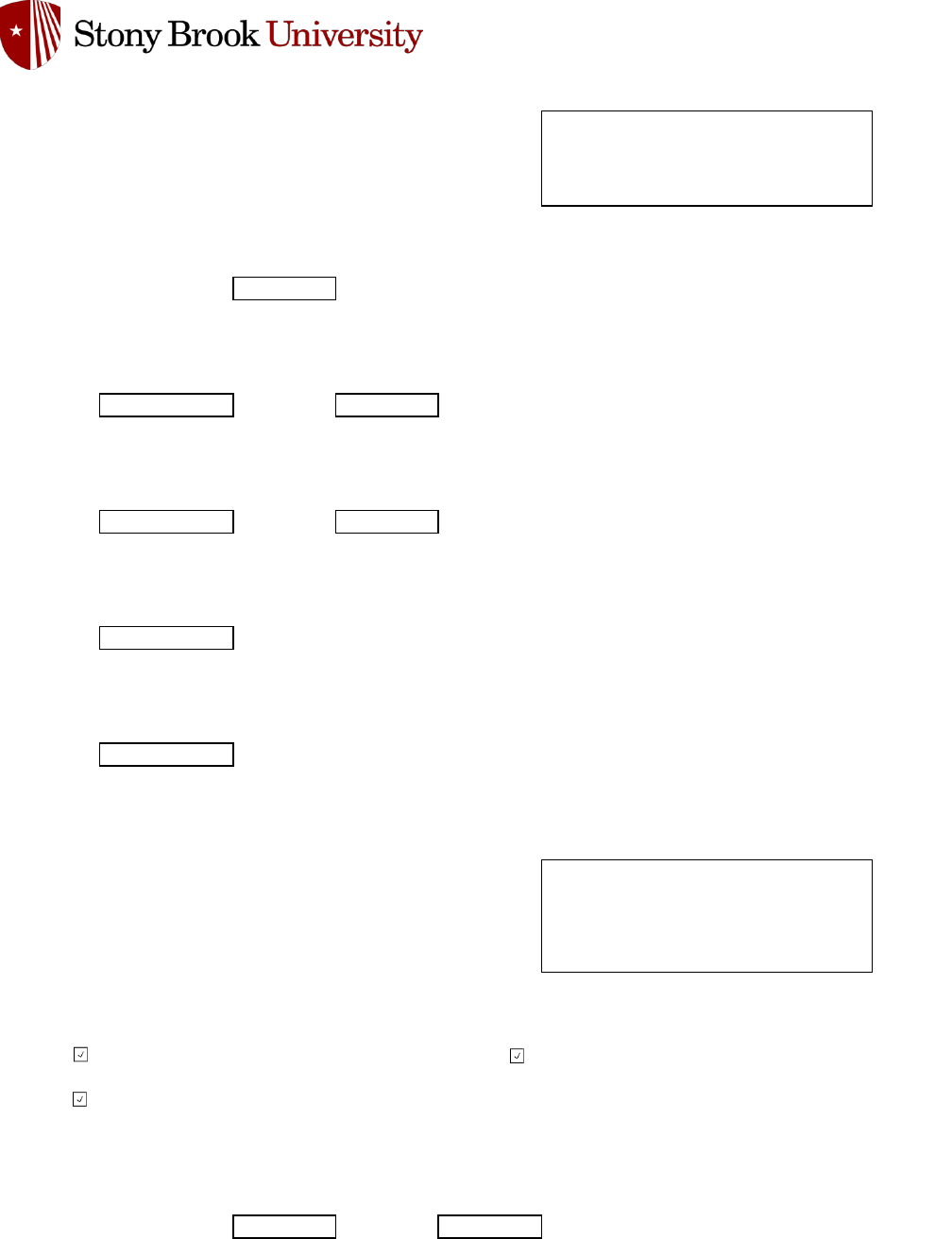
Common Data Set 2023-24
D11. Additional Requirements
Please describe any additional requirements for transfer students, if applicable:
D12. Lowest Grade Allowable for Transfer Credit
Report the lowest grade earned for any course that may be transferred for credit:
Lowest grade: C
D13. Maximum Credits Transferred to two-year institutions
Report the maximum number of credits or courses that may be transferred from a two-year institution:
Number: 84.0 Unit Type: Credit(s)
D14. Maximum Credits Transferred to four-year institutions
Report the maximum number of credits or courses that may be transferred from a four-year institution:
Number: 84.0 Unit Type: Credit(s)
D15. Minimum Credits to Earn Associate Degree
Report the minimum number of credits that transfer students must complete at your institution to earn an associate degree:
Number:
D16. Minimum Credits to Earn Bachelor's Degree
Report the minimum number of credits that transfer students must complete at your institution to earn a bachelor's degree:
Number: 36.0
D17: Other Credit Policies
Please describe any other transfer credit policies:
D18: Military/Veteran Transfer Credits
Does your institution accept the following military/veteran transfer credits: (select all that apply)
D19: Maximum Credits Transferred - ACE
Number: 84.0 Unit Type: Credit(s)
D20: Maximum Credits Transferred - CLEP, DSST
Report the maximum number of credits or courses that may be transferred based on military education evaluated by the American
Council on Education (ACE):
Report the maximum number of credits or courses that may be transferred based on Department of Defense supported prior learning
assessments (College Level Examination Program (CLEP) or DANTES Subject Standardized Tests (DSST)):
American Council on Education (ACE)
DANTES Subject Standardized Tests (DSST)
College Level Examination Program (CLEP)
Prepared by the Stony Brook University Office of Institutional Research, Planning Effectiveness, November 16, 2023

Common Data Set 2023-24
Number: 30.0 Unit Type: Credit(s)
Report the maximum number of credits or courses that may be transferred based on Department of Defense supported prior learning
assessments (College Level Examination Program (CLEP) or DANTES Subject Standardized Tests (DSST)):
Prepared by the Stony Brook University Office of Institutional Research, Planning Effectiveness, November 16, 2023
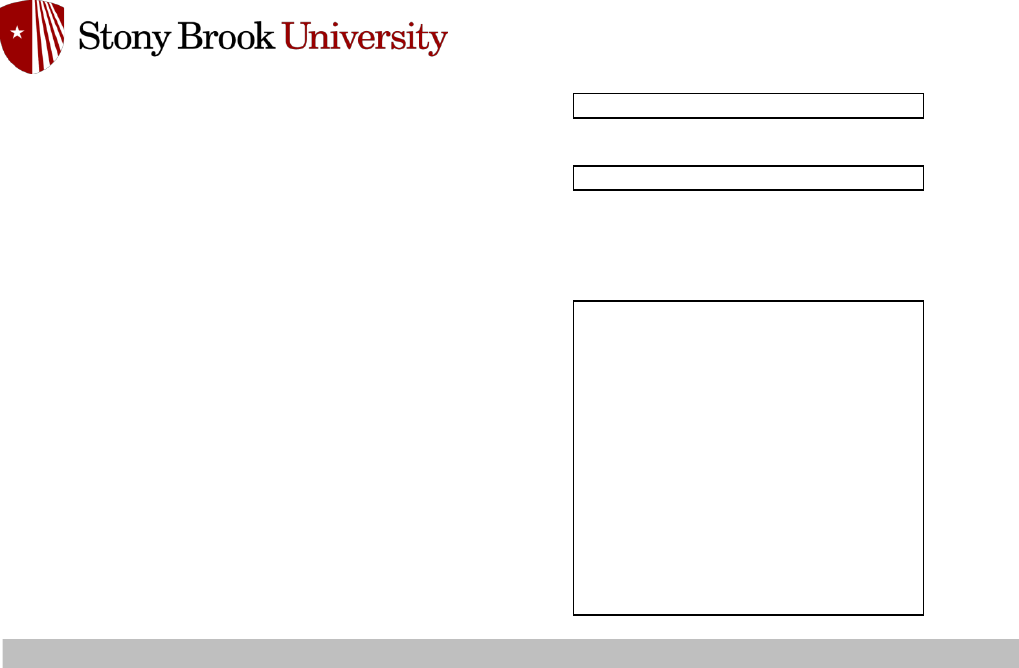
Common Data Set 2023-24
D21: Published Transfer Policies
No
If yes, please provide the URL where the policy can be located:
D22: Unique Transfer Policies
Please describe other military/veteran transfer credit policies unique to your institution:
Are the military/veteran credit transfer policies published on your website?
END OF SECTION D
Prepared by the Stony Brook University Office of Institutional Research, Planning Effectiveness, November 16, 2023

Common Data Set 2023-24
E1. Special study options
Please identify the programs available at your institution. Refer to the glossary for definitions. Select all that apply.
If other,
please specify:
E2. Removed from the CDS.
E3. Required Coursework for Graduation
If "Other" selected, please specify below:
E. ACADEMIC OFFERINGS AND POLICIES
Please indicate the areas in which all, or most, students are required to complete some course work prior to graduation:
Select all that apply.
Accelerated program
Comprehensive transition and postsecondary program for
students with intellectual disabilities
Cross-registration
Distance learning
Double major
Dual enrollment
English as a Second Language (ESL)
Exchange student program (domestic)
External degree program
Honors program
Independent study
Internships
Liberal arts/career combination
Student-designed major
Study abroad
Teacher certification program
Undergraduate Research
Weekend college
Other
Arts / fine arts
Computer literacy
English (including composition)
Foreign languages
History
Physical Education
Humanities
Intensive Writing
Mathematics
Philosophy
Sciences (biological or physical)
Social Science
Other
Prepared by the Stony Brook University Office of Institutional Research, Planning Effectiveness, November 16, 2023
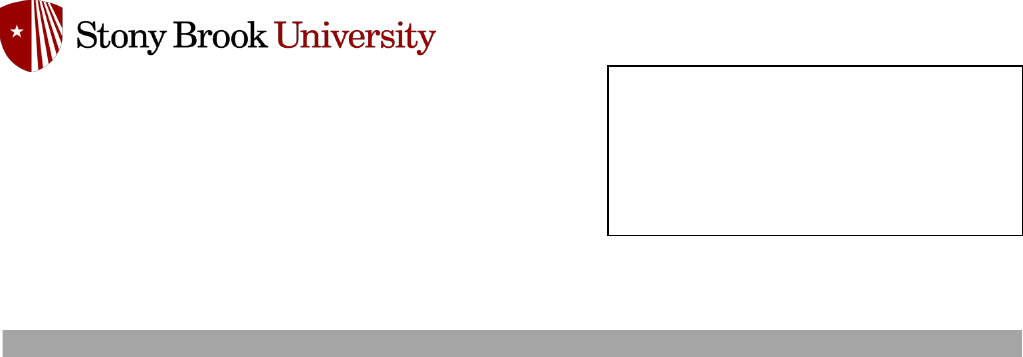
Common Data Set 2023-24
Courses fostering understanding of diversity and world
cultures
END OF SECTION E
Other
Prepared by the Stony Brook University Office of Institutional Research, Planning Effectiveness, November 16, 2023
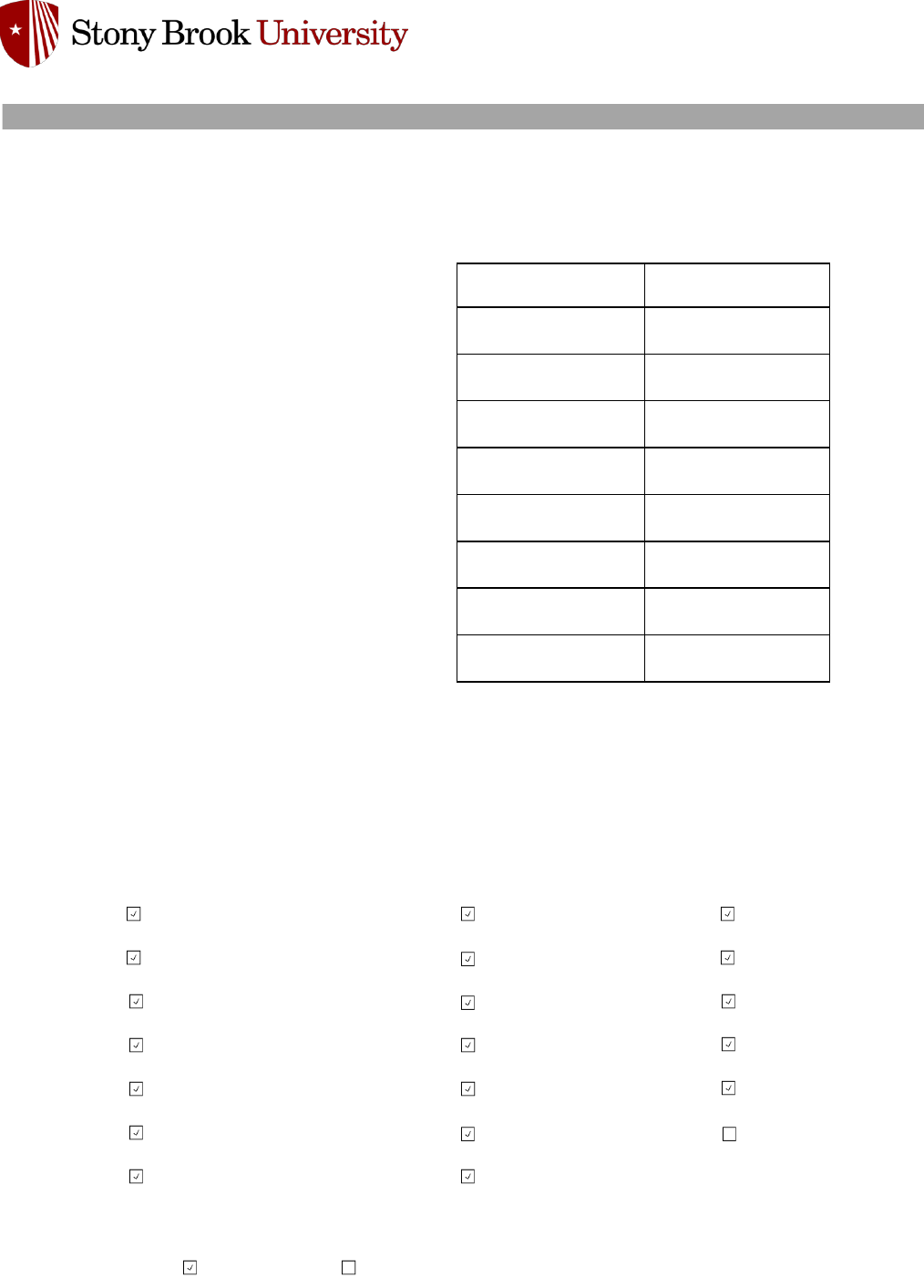
Common Data Set 2023-24
F1. First-time, first-year degree-seeking students and undergraduates enrolled
First-time,
First-year Students
Undergraduates
Percent who are from out of state (exclude international/
non-residents from the numerator and denominator)
11.0% 7.0%
Percent of men who join fraternities 3.0%
Percent of women who join sororities 3.0%
Percent who live in college-owned, -operated, or -affiliated
housing
75.0% 52.0%
Percent who live off campus or commute 25.0% 48.0%
Percent of students age 25 or older 6.0%
Average age of full-time students 18 20
Average age of all students (full-time and part-time) 18 20
F2. Activities Offered
Please identify all programs available at your institution.
F3. ROTC (program offered in cooperation with Reserve Officers' Training Corps) select all that apply.
Army ROTC is offered:
F. STUDENT LIFE
Please complete the table below with the percentages or average age of first-time, first-year degree-seeking students and degree-
seeking undergraduates enrolled in Fall 2023 who fit into the following categories:
Campus Ministries
Choral groups
Concert band
Dance
Drama/theater
International Student Organization
Jazz band
Literary magazine
Marching band
Model UN
Music ensembles
Opera
Pep band
On Campus
At cooperating institution
Radio station
Student government
Student newspaper
Student-run film society
Symphony orchestra
Television station
Yearbook
Prepared by the Stony Brook University Office of Institutional Research, Planning Effectiveness, November 16, 2023

Common Data Set 2023-24
If at cooperating institution, please list institution below:
Naval ROTC is offered:
If at cooperating institution, please list institution below:
Air Force ROTC is offered:
If at cooperating institution, please list institution below:
F4. Housing
Please check all types of college-owned, -operated, or -affiliated housing available for undergraduates at your institution.
If selected "Other Housing Options", please specify below:
END OF SECTION F
Marine Option
On Campus
At cooperating institution
On Campus
At cooperating institution
Apartments for married students
Apartments for single students
Coed residence halls
Cooperative housing
Fraternity/sorority housing
Living Learning Communities
Men's residence halls
Special housing for international students
Special housing for students with disabilities
Theme housing
Women's residence halls
Other Housing Options
Prepared by the Stony Brook University Office of Institutional Research, Planning Effectiveness, November 16, 2023
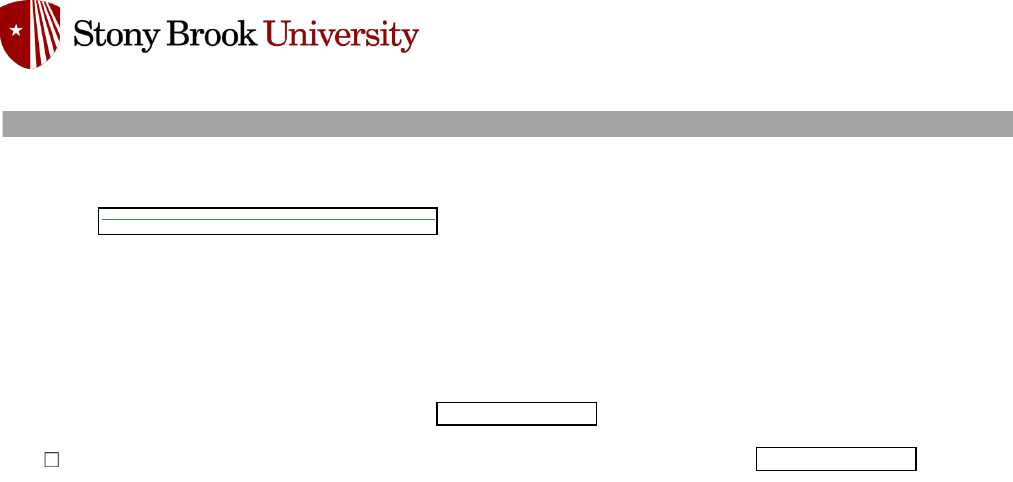
Common Data Set 2023-24
G0. Net Price Calculator URL
Please provide the URL of your instititution's net price calculator:
https://www.stonybrook.edu/commcms/finaid/resources/_net
_price_calc.php
Tuition and Fee Data Provided are:
Approximate date costs will be available:
G1. Undergraduate, full-time tuition, required fees, food and housing
G. ANNUAL EXPENSES
For the following sections, please provide 2024-2025 academic year costs of attendance for the following categories that are applicable to
your institution.
If your institution's 2024-2025 academic year costs of attendance are not available at this time, please select the checkbox below and enter
the approximate date (i.e. MM/DD) when your institution's final 2024-2025 academic year costs of attendance will be available.
List the typical tuition, required fees, and food and housing for a full-time undergraduate student for the full 2024-2025 academic year. (30
semester hours or 45 quarter hours for institutions that derive annual tuition by multiplying credit hour cost by number of credits).
✓ A full academic year refers to the period of time generally extending from September to June; usually equated to two semesters, two
trimesters, three quarters, or the period covered by a four-one-four plan.
✓ Food and housing is defined as double occupancy and 19 meals per week or the maximum meal plan.
✓ Required fees include only charges that all full-time students must pay that are not included in tuition (e.g., registration, health, or activity
fees.)
✓ Do not include optional fees (e.g., parking, laboratory use).
2024-2025 academic costs not currently available
Prepared by the Stony Brook University Office of Institutional Research, Planning Effectiveness, November 16, 2023
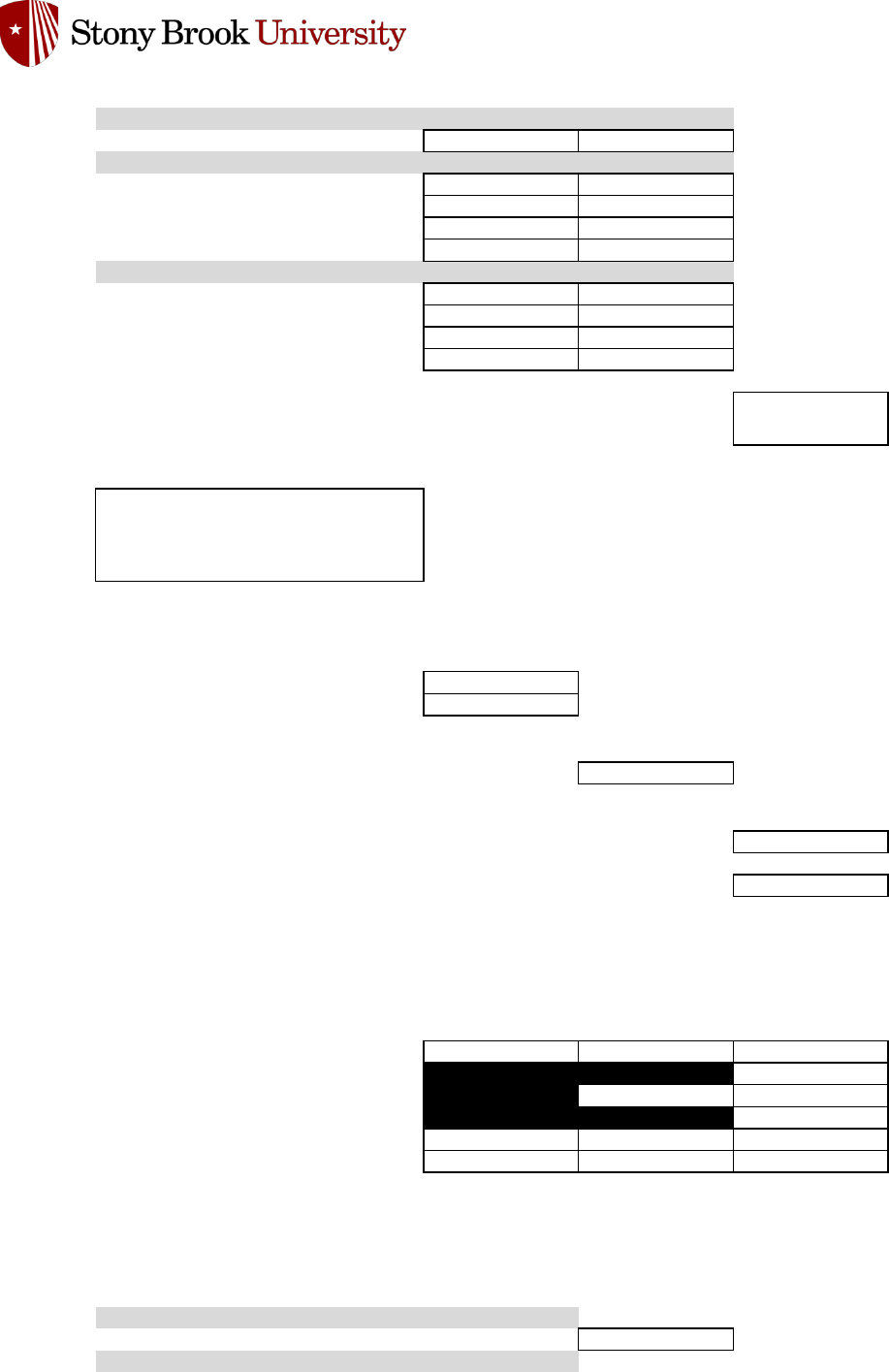
Common Data Set 2023-24
First-Year Undergraduate
PRIVATE INSTITUTION
Tuition:
PUBLIC INSTITUTION
Tuition: In-district
Tuition: In-state (out-of-district): $7,070.00 $7,070.00
Tuition: Out-of-state: $26,860.00 $26,860.00
Tuitition: International (non-resident) $26,860.00 $26,860.00
FOR ALL INSTITUTIONS
Required Fees: $3,489.80 $3,489.80
Food and Housing (on-campus): $17,662.00 $17,662.00
Housing Only (on-campus): $10,612.00 $10,612.00
Food Only (on-campus meal plan): $7,050.00 $7,050.00
G2. Credits Per Term
Please enter the number of credits per term a student can take for the stated full-time tuition:
Minimum number of credits: 12.0
Maximum number of credits: 23**
**students on approved overloads can go up to 23 credits
G3. Tuition and Fee Variance by Year of Study
Do tuition and fees vary by year of study (e.g. sophomore, junior, senior)? No
G4. Tuition and Fee Variance by Undergraduate Instructional Program
Do tuition and fees vary by undergraduate instructional program? No
If yes, what percent of full-time undergraduates pay more than the tuition and fees reported in G1?
G5. Estimated Expenses for Typical Full-Time Undergraduates
Please provide estimated expenses for a typical full-time undergraduate student:
Residents
Commuters
(living at home)
Commuters
(not living at home)
Books and supplies: $900.00 $900.00 $900.00
Housing only: $10,336.00
Food only: $5,640.00 $5,640.00
Food and housing total*
Transportation: $840.00 $4,744.00 $4,744.00
Other expenses: $2,408.00 $2,408.00 $2,408.00
G6. Undergraduate Per-Credit-Hour Charges (tuition only)
Please enter the undergraduate per-credit-hour charges (tuition only) in the applicable institution type and segment of students:
PRIVATE INSTITUTIONS
PUBLIC INSTITUTIONS
If your institution has comprehensive tuition, food and housing fees (and cannot provide separate fee
amounts), please enter that comprehensive amount:
*Only enter "Food and housing total" if your institution cannot provide separate food and housing figures for commuters not living at home.
Per-credit-hour charge (tuition only):
Other tuition or fee information:
Prepared by the Stony Brook University Office of Institutional Research, Planning Effectiveness, November 16, 2023

Common Data Set 2023-24
$295.00
$1,119.00
$1,119.00
In-district students, per-credit-hour charge (tuition only):
In-state (out-of-district) students, per-credit-hour charge (tuition only):
Out-of-state students, per-credit-hour charge (tuition only):
END OF SECTION G
International (non-resident) students, per-credit-hour charge (tuition only):
Prepared by the Stony Brook University Office of Institutional Research, Planning Effectiveness, November 16, 2023

Common Data Set 2023-24
H1. Aid Awarded to Enrolled Undergraduates
H. FINANCIAL AID
Please refer to the following financial aid definitions when completing Section H.
Awarded aid: The dollar amounts offered to financial aid applicants.
Financial aid applicant: Any applicant who submits any one of the institutionally required financial aid applications/forms, such as the FAFSA.
Indebtedness: Aggregate dollar amount borrowed through any loan program (federal, state, subsidized, unsubsidized, private, etc.; excluding
parent loans) while the student was enrolled at an institution. Student loans co-signed by a parent are assumed to be the responsibility of the
student and should be included.
Institutional scholarships and grants: Endowed scholarships, annual gifts and tuition funded grants for which the institution determines the
recipient.
Financial need: As determined by your institution using the federal methodology and/or your institution's own standards.
Need-based aid: College-funded or college-administered award from institutional, state, federal, or other sources for which a student must
have financial need to qualify. This includes both institutional and non-institutional student aid (grants, jobs, and loans).
Need-based scholarship or grant aid: Scholarships and grants from institutional, state, federal, or other sources for which a student must have
financial need to qualify.
Need-based self-help aid: Loans and jobs from institutional, state, federal, or other sources for which a student must demonstrate financial
need to qualify.
Non-need-based scholarship or grant aid: Scholarships and grants, gifts, or merit-based aid from institutional, state, federal, or other sources
(including unrestricted funds or gifts and endowment income) awarded solely on the basis of academic achievement, merit, or any other non-
need-based reason. When reporting questions H1 and H2, non-need-based aid that is used to meet need should be counted as need-based
aid.
Note: Suggested order of precedence for counting non-need money as need-based:
1.Non-need institutional grants 6. Non-need outside grants
2.Non-need tuition waivers 7. Non-need student loans
3.Non-need athletic awards 8. Non-need parent loans
4.Non-need federal grants 9. Non-need work
5.Non-need state grants
Non-need-based self-help aid: Loans and jobs from institutional, state, or other sources for which a student need not demonstrate financial
need to qualify.
Private student loans: A nonfederal loan made by a lender such as a bank, credit union or private lender used to pay for up to the annual cost
of education, less any financial aid received.
External scholarships and grants: Scholarships and grants received from outside (private) sources that students bring with them (e.g., Kiwanis,
National Merit scholarships). The institution may process paperwork to receive the dollars, but it has no role in determining the recipient or
the dollar amount awarded.
Work study and employment: Federal and state work study aid, and any employment packaged by your institution in financial aid awards.
Enter total dollar amounts awarded to enrolled full-time and less than full-time degree-seeking undergraduates (using the same cohort
reported in CDS Question B1, “total degree-seeking” undergraduates) in the following categories.
Prepared by the Stony Brook University Office of Institutional Research, Planning Effectiveness, November 16, 2023
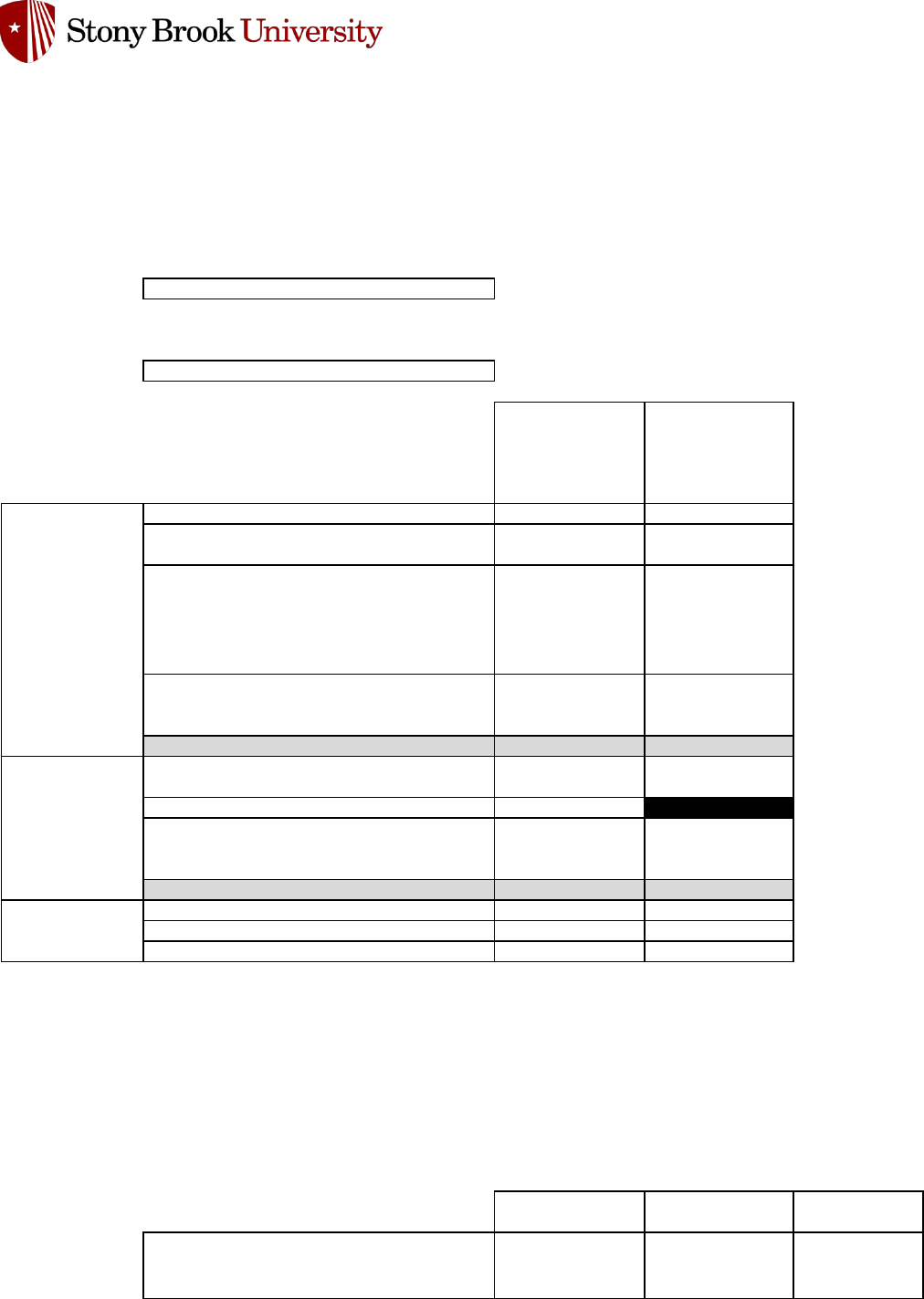
Common Data Set 2023-24
Indicate the academic year for which data are reported for items H1, H2, H2A, and H6 below:
2022-2023 Final
Which needs-analysis methodology does your institituion use in awarding institutional aid? (formerly CDS - H3)
Federal methodology (FM)
Need-Based
(Include non-need
based aid use to meet
need).
Non-Need-Based
(Exclude non-need-
based aid use to meet
need).
Federal $38,773,165 $519,962
State - all states, not only the state in which
your institution is located
$29,267,214 $2,356,728
Instititutional - Endowed scholarships, annual
gifts and tuition funded grants, awarded by
the college, excluding athletic aid and tuition
waivers (which are reported below)
$20,029,834 $10,033,455
Scholarships/grants from external sources
(e.g. Kiwanis, National Merit) not awarded by
the college
$1,179,047 $1,391,163
Total Scholarships/Grants
$89,249,260 $14,301,308
Student loans from all sources
(excluding parent loans)
$71,383,527 $25,412,718
Federal Work-Study $1,508,071
State and other (e.g., institutional) work-
study/employment (Note: excludes Federal
Work/Study captured above)
$5,013,799 $6,503,419
Total Self-Help $77,905,397 $31,916,138
Parent Loans $6,265,463 $6,835,938
Tuition Waivers
Athletic Awards $1,880,709 $4,760,222
H2. Number of Enrolled Students Awarded Aid
Full-Time, First-Time,
First-Year
Full-Time Undergrad.
(Include Freshman)
Less Than Full-
Time Undergrad.
A. Number of degree-seeking undergraduate
students (CDS Item B1 if reporting on Fall 2023
cohort)
3,342 16,314 1,092
✔️ Do not include any aid related to the CARES Act or unique to the COVID-19 pandemic.
✔️ Aid that is non-need-based but that was used to meet need should be reported in the need-based aid column.
✔️ For a suggested order of precedence in assigning categories of aid to cover need, see the entry for “non-need-
based scholarship or grant aid” on the last page of the definitions section.
Do NOT include any aid related to the CARES Act or unique to the COVID-19 pandemic.
H1. Aid Awarded to Enrolled Undergraduates
Scholarships /
Grants
Self Help
MISC.
List the number of degree-seeking full-time and less-than-full-time undergraduates who applied for and were awarded financial aid from any
source.
✔️ Aid that is non-need-based but that was used to meet need should be counted as need-based aid.
✔️ Numbers should reflect the cohort awarded dollars reported in H1.
✔️ In the chart below, students may be counted in more than one row, and full-time, first-time, first-year students should also be
counted as full-time undergraduates.
✔️ Include aid awarded to international students (i.e., those not qualifying for federal aid).
✔️ If the data being reported are final figures for the 2022-2023 academic year, use the 2022-2023 academic year's CDS Question
B1 Cohort.
Prepared by the Stony Brook University Office of Institutional Research, Planning Effectiveness, November 16, 2023

Common Data Set 2023-24
B. Number of students in line (A) who applied for
need-based financial aid
2,925 12,144 513
C. Number of students in line (B) who were
determined to have financial need
2,194 10,055 459
D. Number of students in line (C) who were awarded
any financial aid
2,177 9,872 393
E. Number of students in line (D) who were awarded
any need-based scholarship or grant aid
2,004 8,647 275
F. Number of students in line (D) who were awarded
any need-based self-help aid
1,987 9,003 335
G. Number of students in line (D) who were awarded
any non-need-based scholarship or grant aid
154 564 2
H. Number of students in line (D) who need was fully
met (exclude PLUS loans, unsubsidized loans, and
private alternative loans)
212 1,065 26
I. On average, the percentage of need that was met
of students who were awarded any need-based aid.
Exclude any aid that was awarded in excess of need
as well as any resources that were awarded to
replace EFC (PLUS loans, unsubsidized loans, and
private alternative loans).
60.6% 59.0% 32.3%
J. The average financial aid package of those in line
(D). Exclude any resources that were awarded to
replace EFC (PLUS loans, unsubsidized loans, and
private alternative loans).
$14,967 $14,547 $6,173
K. Average need-based scholarship or grant award of
those in line (E)
$11,767 $10,155 $3,330
L. Average need-based self-help award (excluding
PLUS loans, unsubsidized loans, and private
alternative loans) of those in line (F)
$3,918 $5,565 $4,389
M. Average need-based loan (excluding PLUS loans,
unsubsidized loans, and private alternative loans) of
those in line (F) who were awarded a need-based
loan
$3,569 $4,722 $4,142
H2A. Number of Enrolled Students Awarded Non-Need-Based Scholarships and Grants
Full-Time, First-Time,
First-Year
Full-Time Undergrad.
(Include Freshman)
Less Than Full-
Time Undergrad.
List the number of degree-seeking full-time and less-than-full-time undergraduates who had no financial need and who were awarded
institutional non-need-based scholarship or grant aid.
✔️Numbers should reflect the cohort awarded the dollars reported in H1.
✔️In the chart below, students may be counted in more than one row, and full-time, first-time, first-year students should also be
counted as full-time undergraduates.
✔️Do not include any aid related to the CARES Act or unique to the COVID-19 pandemic.
Prepared by the Stony Brook University Office of Institutional Research, Planning Effectiveness, November 16, 2023

Common Data Set 2023-24
N. Number of students in line (A) who had no
financial need and who were awarded institutional
non-need-based scholarship or grant aid (exclude
those who were awarded athletic awards and tuition
benefits)
690 1,990 19
O. Average dollar amount of institutional non-need-
based scholarship and grant aid awarded to students
in line (N)
$3,690 $4,703 $3,156
P. Number of students in line (A) who were awarded
an instutional non-need-based athletic scholarship or
grant
60 217 1
Q. Average dollar amount of institutional non-need-
based athletic scholarships and grants awarded to
students in line (P)
$18,797 $21,921 $3,296
The graduates and loan types to include and exclude in order to fill out CDS H4 and CDS H5 are listed below:
INCLUDE:
EXCLUDE:
H4. 2023 Undergraduate Class
2,739
H5. Number/Percent Borrowers and Average Borrowed Amount
Provide the number of students in the 2023 undergraduate class who started at your institution as
first-time students and received a bachelor's degree between July 1, 2022 and June 30, 2023.
Exclude students who transferred into your institution.
Provide the number and percent of students in class (defined in H4 above) borrowing from federal, non-federal, and any loan sources, and the
average (or mean) amount borrowed in the table below.
The "average per-undergraduate-borrower cumulative principal borrowed" is designed to provide better information about
student borrowing from federal and nonfederal (institutional, state, commercial) sources.
The numbers, percentages, and averages for each row should be based only on the loan source specific for the particular row. For
example, the federal loans average (Row B) should only be the cumulative average of federal loans and the private loans average
(Row E) should only the cumulative average of private loans.
➖ Any aid related to the CARES Act or unique to the COVID-19 pandemic.
✔️ 2023 undergraduate class = all students who started at your institution as first-time students and received a bachelor's degree
between July 1, 2022 and June 30, 2023.
✔️ Only loans made to students who borrowed while enrolled at your institution.
✔️ Co-signed loans.
➖ Students who transferred in.
➖ Money borrowed at other institutions.
➖ Parent loans.
➖ Students who did not graduate or who graduated with another degree or certificate (but no bachelor's degree).
Prepared by the Stony Brook University Office of Institutional Research, Planning Effectiveness, November 16, 2023
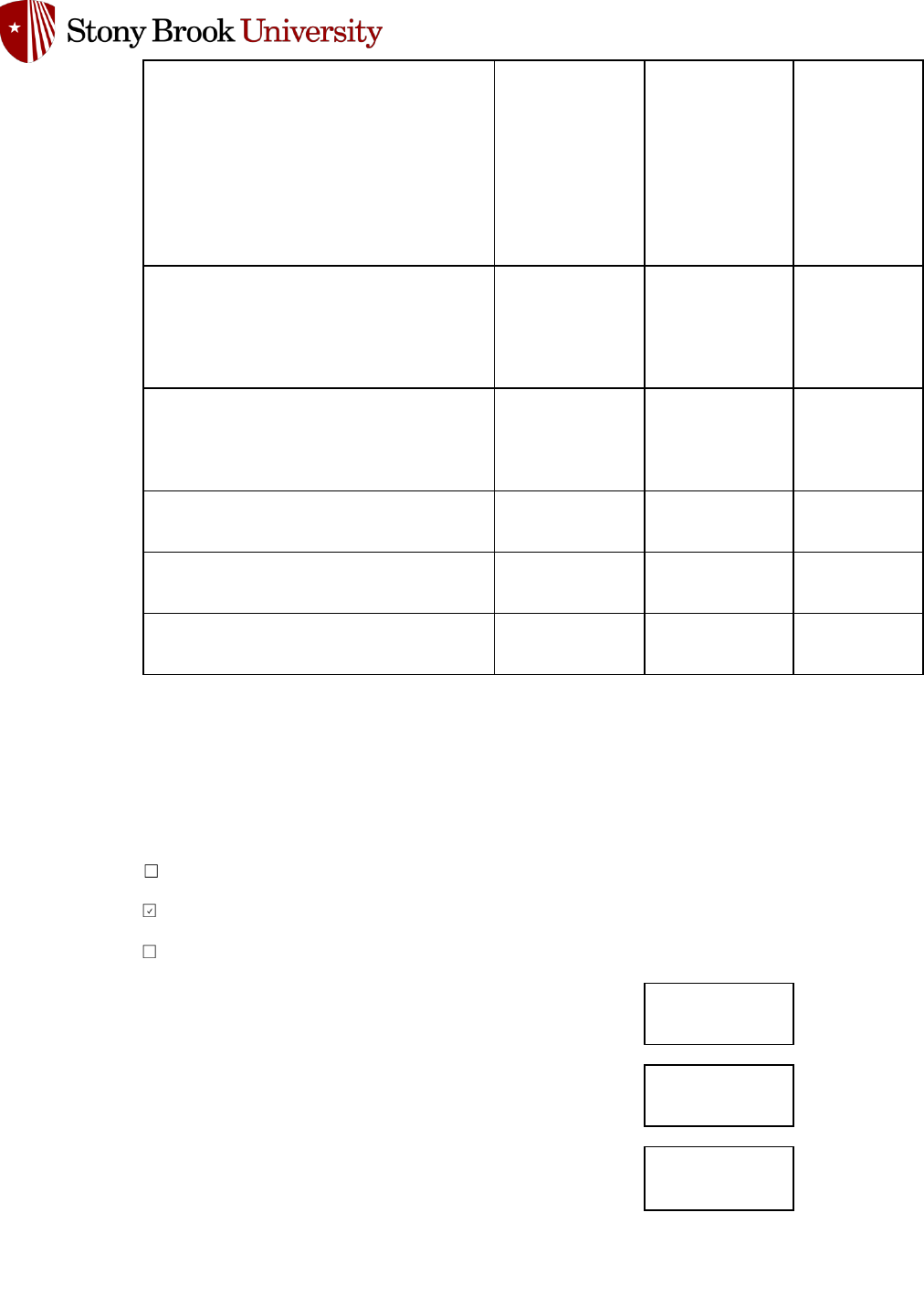
Common Data Set 2023-24
Source/Type of Loan
Number in the class
(defined in H4 above)
who borrowed from
the types of loans
specific in the first
column
Percent of the class
(defined above) who
borrowed from the
types of loans
specified in the first
column (nearest 1%)
Average per-
undergraduate-
borrower
cumulative
principal
borrowed from
the types of loans
specific in the first
column (nearest
$1)
A. Any loan program: Federal Perkins, Federal
Stafford Subsidized and Unsubsidized, institutional,
state, private loans that your institution is aware of,
etc. Include both Federal Direct Student Loans and
Federal Family Education Loans.
1,124 41% $22,695
B. Federal loan programs: Federal Perkins, Federal
Stafford Subsidized and Unsubsidized. Include both
Federal Direct Student Loans and Federal Family
Education Loans.
1,105 40% $18,090
C. Institutional loan program
D. State loan programs
E. Private student loans made by a bank or lender
162 6% $34,072
H6. Aid to Undergraduate Degree-Seeking Nonresidents
Report numbers and dollar amounts for the same academic year as checked in item H1.
H1 Response: 2022-2023 Final
Indicate your instititution's policy regarding institutional scholarship and grant aid for undergraduate degree-seeking nonresidents:
416
$3,298
$1,372,093
H7. Process for Nonresident First-Year Students
Select all financial aid forms that nonresident first-year financial aid applicants must submit:
Total dollar amount of institutional financial aid awarded to undergraduate degree-seeking
nonresidents:
If institutional financial aid is available for undergraduate degree-seeking nonresidents, provide
the number of undergraduate degree-seeking nonresidents who were awarded need-based or non-
need-based aid:
Average dollar amount of institutional financial aid awarded to undergraduate degree-seeking
nonresidents:
Institutional need-based scholarship or grant aid is available
Institutional non-need-based scholarship or grant aid is available
Institutional scholarship and grant aid is not available
Institution's own financial aid form
Prepared by the Stony Brook University Office of Institutional Research, Planning Effectiveness, November 16, 2023
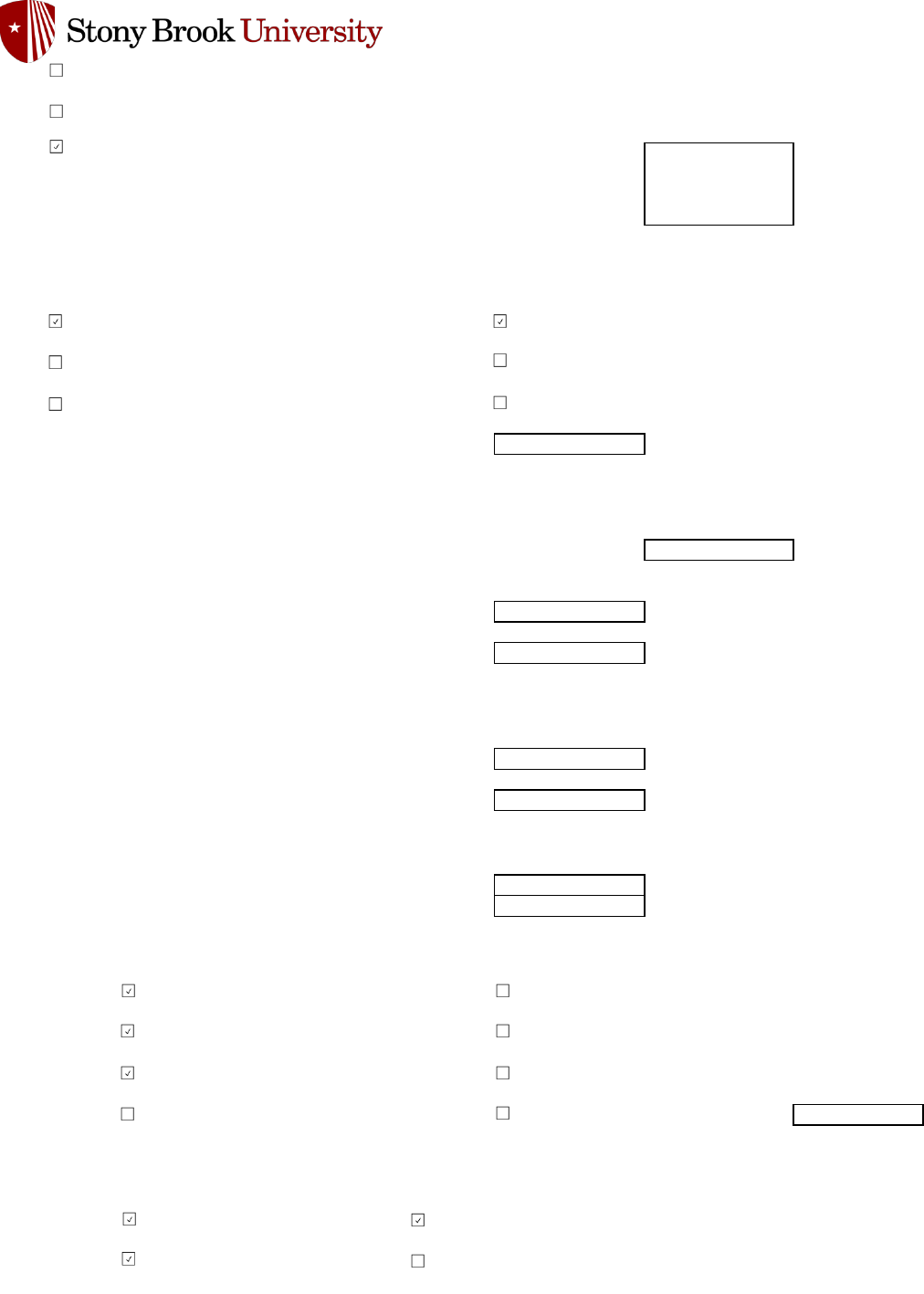
Common Data Set 2023-24
Other:
International
Student’s Certification
of Finances
H8. Process for First-Year Students
Select all financial aid forms domestic first-year financial aid applicants must submit:
Other:
H9. Filing Dates for First-Year Students
Does institution have a deadline for filing required financial aid forms for first-year students? No
Select "no" if there is no deadline and applications are processed on a rolling basis.
Priority date for filing required financial aid forms: (MM/DD) 3/1
Deadline for filing required financial aid forms: (MM/DD)
H10. Notification Dates for First-Year Students
Please enter the date for only one response below based on whether students are notified on a certain date or notified on a rolling basis.
Students are notificed on or about (date): (MM/DD)
Students are notified on a rolling basis starting (date): (MM/DD) 4/1
H11. Reply Dates for First-Year Students
Students must reply by (date): (MM/DD) 5/1
or within (number) of weeks of notification:
H12. Types of Aid Available - Loans
Please select all types of aid available to undergraduates at your institution:
Please specify:
H13. Types of Aid Available - Need-Based Scholarships and Grants
Please select all types of aid available to undergraduates at your institution:
Institution's own financial aid form
CSS Profile
Other; please specify.
FAFSA
Institution's own financial aid form
CSS Profile
State aid form
Other; please enter below.
Business/Farm Supplement
Direct Subsidized Stafford Loans
Direct Unsubsidized Stafford Loans
Direct PLUS Loans
Federal Perkins Loans
Federal Nursing Loans
State Loans
College/University loans from institutional funds
Other
Federal Pell
SEOG
State scholarship/grants
College/University scholarship or grant aid from institutional funds
United Negro College Fund
Federal Nursing Scholarship
Prepared by the Stony Brook University Office of Institutional Research, Planning Effectiveness, November 16, 2023
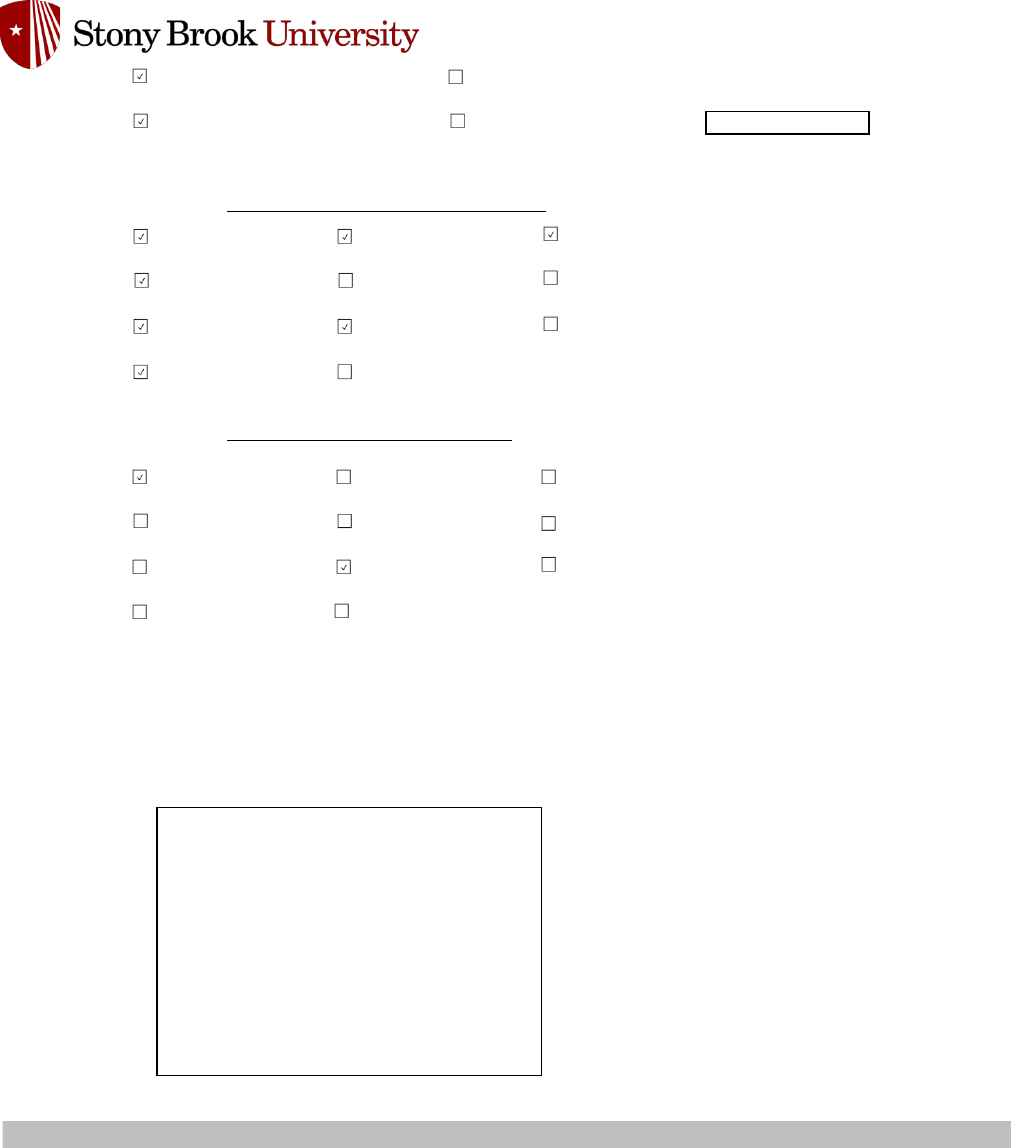
Common Data Set 2023-24
Please specify:
H14. Criteria Used in Awarding Institutional Aid
Please select all criteria used in awarding non-need based institutional aid:
H14. Criteria Used in Awarding Institutional Aid
Please select all criteria used in awarding need-based institutional aid:
H15. Affordable Policies
If your institution has recently implemented any major financial aid policy, program, or iniative to make your institution more affordable to
incoming students such as replacing loans with grants, or waiving costs for families below a certain income level, please provide the details
below:
END OF SECTION H
State scholarship/grants
Private scholarships
Federal Nursing Scholarship
Other
Academics
Alumni affiliation
Art
Athletics
Job skills
ROTC
Leadership
Minority status
Music/drama
Religious affiliation
State/district residency
Academics
Alumni affiliation
Art
Athletics
Job skills
ROTC
Leadership
Religious affiliation
State/district residency
Minority status
Music/drama
Prepared by the Stony Brook University Office of Institutional Research, Planning Effectiveness, November 16, 2023
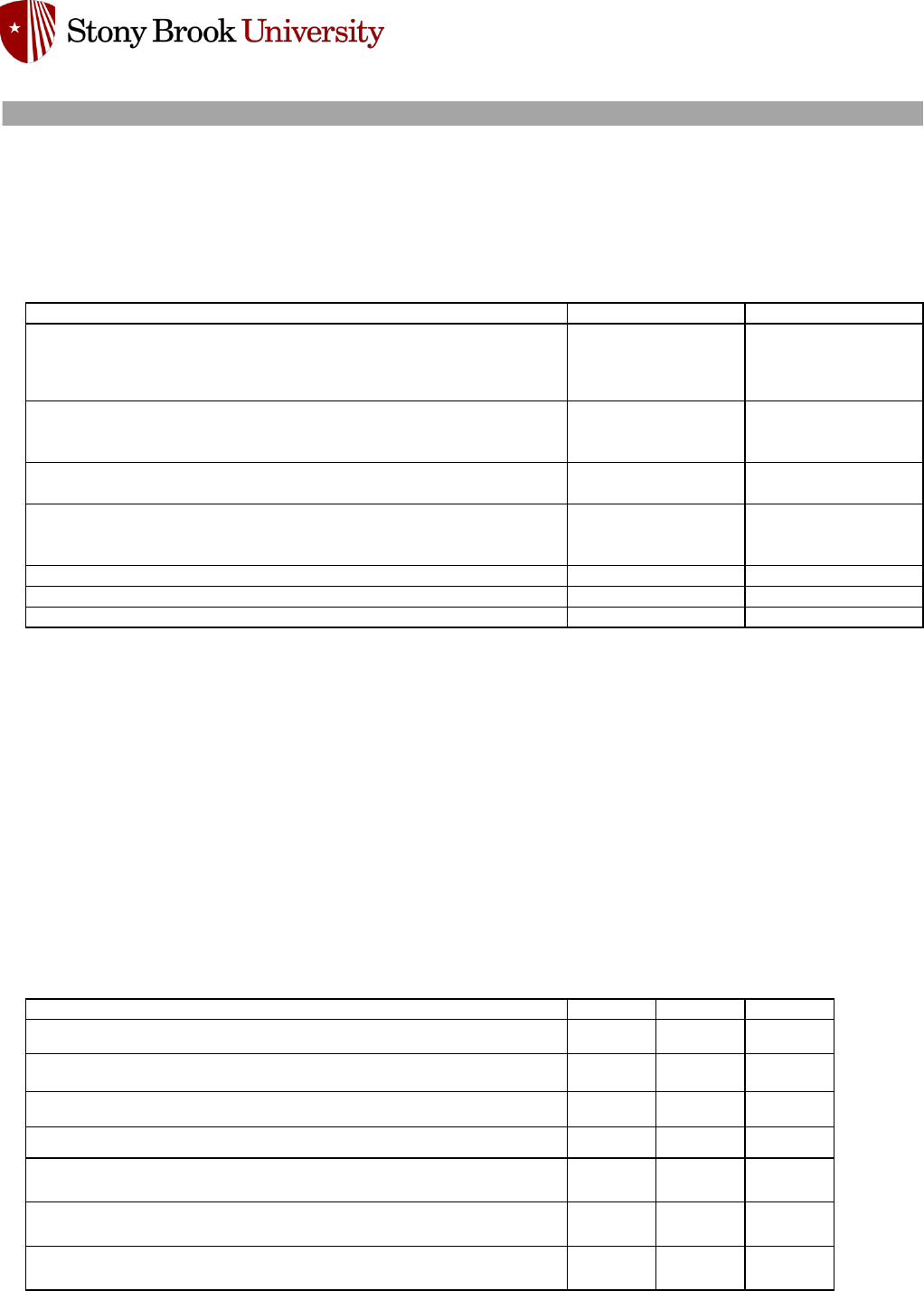
Common Data Set 2023-24
I1. Instructional Faculty by Category
A. Instructional faculty in preclinical and clinical medicine, faculty who are not paid
(e.g., those who donate their services or are in the military), or research-only
faculty, post-doctoral fellows, or pre-doctoral fellows
B. Administrative officers with titles such as dean of students, librarian, registrar,
coach, and the like, even though they may devote part of their time to classroom
instruction and may have faculty status
C. Other administrators/staff who teach one or more non-clinical credit courses
even though they do not have faculty status
D. Undergraduate or graduate students who assist in the instruction of courses,
but have titles such as teaching assistant, teaching fellow, and the like
E. Faculty on sabbatical or leave with pay
F. Faculty on leave without pay
G. Replacement faculty for faculty on sabbatical leave or leave with pay
Full-Time Part-Time Total
A. Total number of instructional faculty 1100 559 1659
B. Total number who are members of minority groups 280 113 393
C. Total number who are women 441 287 728
D. Total number who are men 659 272 931
E. Total number who are international (non-residents) 52 11 63
F. Total number with docorate, or other terminal degrees 993 284 1277
G. Total number whose highest degree is a master's degree but not a terminal
master's
89 194 283
Exclude
Exclude
Exclude
Include
Full-time instructional faculty: faculty employed on a full-time basis for instruction (including those with released time for research).
Part-time instructional faculty: Adjuncts and other instructors being paid solely for part-time classroom instruction. Also includes full-time
faculty teaching less than two semesters, three quarters, two trimesters, or two four-month sessions. Employees who are not considered full-
time instruction faculty but who teach one or more non-clinical credit courses may be counted as part-time faculty.
Minority faculty : includes faculty who designate themselves as Black, non-Hispanic; American Indian or Alaska Native; Asian, Native Hawaiian
or other Pacific Islander, or Hispanic.
Doctorate: includes such degrees as Doctor of Philosophy, Doctor of Education, Doctor of Juridical Science, and Doctor of Public Health in any
field such as arts, sciences, education, engineering, business, and public administration. Also includes terminal degrees formerly designated as
“first professional,” including dentistry (DDS or DMD), medicine (MD), optometry (OD), osteopathic medicine (DO), pharmacy (DPharm or
BPharm), podiatric medicine (DPM), veterinary medicine (DVM), chiropractic (DC or DCM), or law (JD).
Terminal master’s degree: a master’s degree that is considered the highest degree in a field: example, M. Arch (in architecture) and MFA
(master of fine arts in art or theater).
I. INSTRUCTIONAL FACULTY AND CLASS SIZE
Please report the number of instructional faculty members in each category for Fall 2023. Include faculty who are on your institution’s payroll
on the census date your institution uses for IPEDS/AAUP.
The following definition of full-time instructional faculty is used by the American Association of University Professors (AAUP) in its annual
Faculty Compensation Survey (the part time definitions are not used by AAUP). Instructional Faculty is defined as those members of the
instructional-research staff whose major regular assignment is instruction, including those with released time for research. Use the chart
below to determine inclusions and exclusions:
Full-Time
Exclude
Part-Time
Include only if they teach
one or more non-clinical
credit courses
Exclude
Include
Exclude
Include only if they teach
one or more non-clinical
credit courses
Include
Exclude
Exclude
Exclude
Prepared by the Stony Brook University Office of Institutional Research, Planning Effectiveness, November 16, 2023
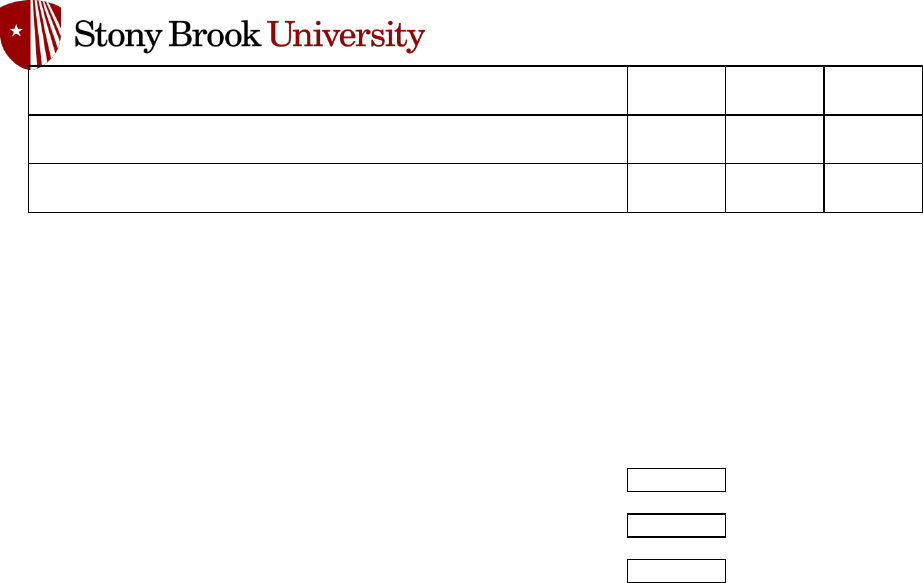
Common Data Set 2023-24
H. Total number whose highest degree is a bachelor's 15 71 86
I. Total number whose highest degree is unknown or other 3 9 12
J. Total number in stand-alone graduate/professional programs in which faculty
teach virtually only graduate-level students
126 180 306
NOTE: Rows F, G, H and I should equal row A.
I2. Student to Faculty Ratio
Fall 2023 Student to Faculty Ratio:
19 to 1
Ratio is based on number of students:
21391
Ratio is based on number of faculty:
1100
Report the Fall 2023 ratio of full-time equivalent students (full-time plus 1/3 part time) to full-time equivalent instructional faculty (full time
plus 1/3 part time). In the ratio calculations, exclude both faculty and students in stand-alone graduate or professional programs such as
medicine, law, veterinary, dentistry, social work, business, or public health in which faculty teach virtually only graduate level students.
Do not count undergraduate or graduate student teaching assistants as faculty.
Prepared by the Stony Brook University Office of Institutional Research, Planning Effectiveness, November 16, 2023
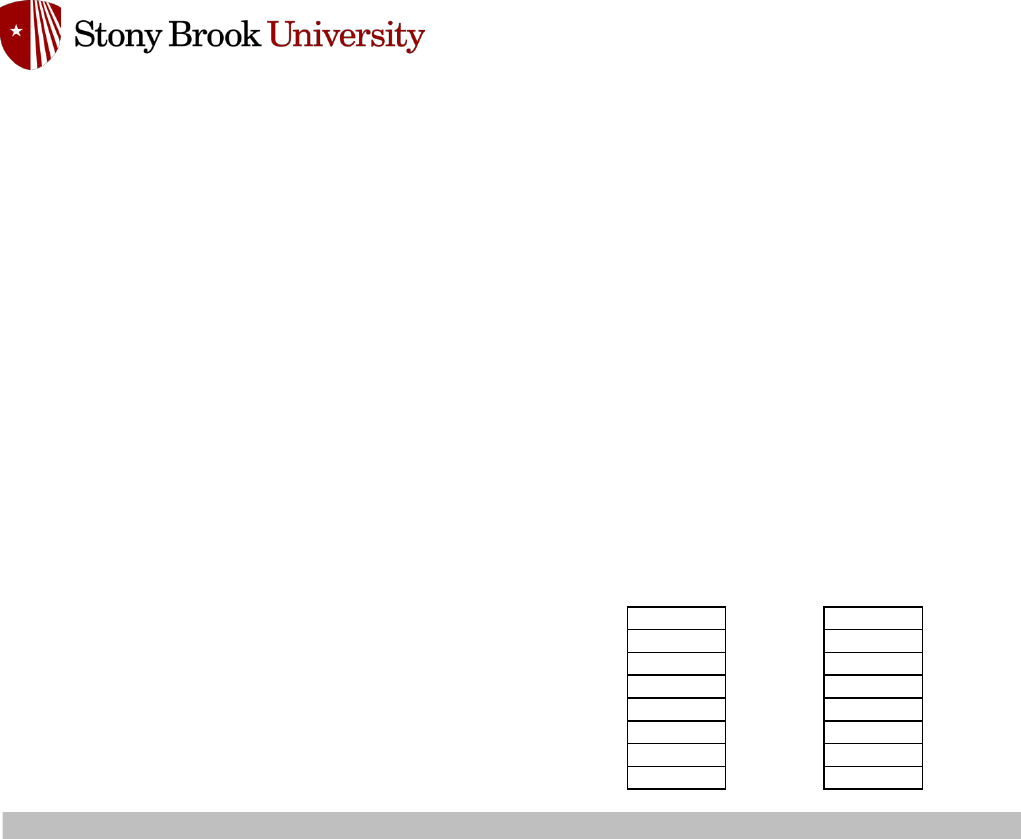
Common Data Set 2023-24
I3. Undergraduate Class Size
Class
Sections
Class Sub-
Sections
2 - 9
166 180
10 - 19
476 265
20 - 29
477 259
30 - 39
193 183
40 - 49
90 14
50 - 59
197 12
100 +
156 6
Total
1755 919
END OF SECTION I
Using the above definitions, please report for each of the following class-size intervals the number of class sections and class subsections
offered in Fall 2023. For example, a lecture class with 800 students who met at another time in 40 separate labs with 20 students should be
counted once in the “100+” column in the class section column and 40 times under the “20-29” column of the class subsections table.
In the table below, please report information about the size of classes and class sections offered in the Fall 2023 term.
Class Sections: A class section is an organized course offered for credit, identified by discipline and number, meeting at a stated time or times
in a classroom or similar setting, and not a subsection such as a laboratory or discussion session. Undergraduate class sections are defined as
any sections in which at least one degree-seeking undergraduate student is enrolled for credit. Exclude distance learning classes and noncredit
classes and individual instruction such as dissertation or thesis research, music instruction, or one-to-one readings. Exclude students in
independent study, co-operative programs, internships, foreign language taped tutor sessions, practicums, and all students in one-on-one
classes. Each class section should be counted only once and should not be duplicated because of course catalog cross-listings.
Class Subsections: A class subsection includes any subsection of a course, such as laboratory, recitation, and discussion subsections that are
supplementary in nature and are scheduled to meet separately from the lecture portion of the course. Undergraduate subsections are defined
as any subsections of courses in which degree-seeking undergraduate students enrolled for credit. As above, exclude noncredit classes and
individual instruction such as dissertation or thesis research, music instruction, or one-to-one readings. Each class subsection should be
counted only once and should not be duplicated because of cross-listings.
Number of class sections with undergraduates enrolled --
Undergraduate Class Size (provide numbers)
Prepared by the Stony Brook University Office of Institutional Research, Planning Effectiveness, November 16, 2023
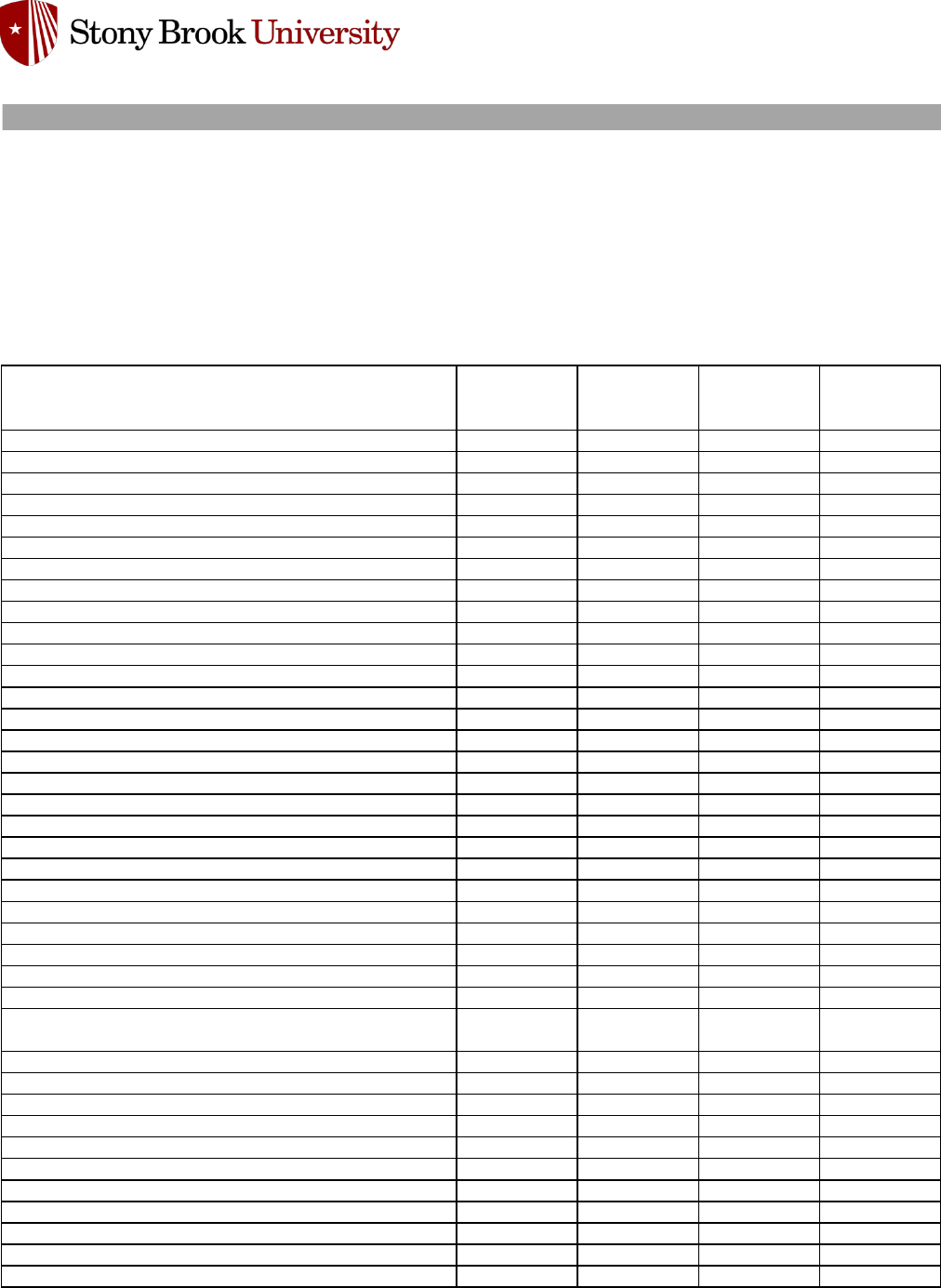
Common Data Set 2023-24
Degrees conferred between July 1, 2022 and June 30, 2023.
Category
Diploma/
Certificates
Associate Bachelor's
CIP 2020
Categories to
Include
Agriculture 1
Natural resources and conservation
0.9
3
Architecture
0.4
4
Area, ethnic, and gender studies
0.5
5
Communication/journalism
1.1
9
Communication technologies 10
Computer and information sciences
6.5
11
Personal and culinary services 12
Education
0.6
13
Engineering
6.1
14
Engineering technologies 15
Foreign languages, literatures, and linguistics
1.0
16
Family and consumer sciences 19
Law/legal studies 22
English
1.8
23
Liberal arts/general studies 24
Library science 25
Biological/life sciences
14.3
26
Mathematics and statistics
9.4
27
Military science and military technologies 28 and 29
Interdisciplinary studies
3.3
30
Parks and recreation 31
Philosophy and religious studies
0.2
38
Theology and religious vocations 39
Physical sciences
3.1
40
Science technologies 41
Psychology
12.5
42
Homeland Security, law enforcement, firefighting,
and protective services
43
Public administration and social services
1.4
44
Social sciences
11.0
45
Construction trades 46
Mechanic and repair technologies 47
Precision production 48
Transportation and materials moving 49
Visual and performing arts
1.4
50
Health professions and related programs
13.4
51
Business/marketing
10.0
52
History
1.3
54
Other
J. DISCIPLINARY AREAS of DEGREES CONFERRED
For each of the following discipline areas, provide the percentage of diplomas/certificates, associate, and bachelor’s degrees awarded. To
determine the percentage, use majors, not headcount (e.g., students with one degree but a double major will be represented twice).
Calculate the percentage from your institution’s IPEDS Completions by using the sum of 1
st
and 2
nd
majors for each CIP code as the
numerator and the sum of the Grand Total by 1st Majors and the Grand Total by 2
nd
major as the denominator. If you prefer, you can
compute the percentages using 1
st
majors only.
Prepared by the Stony Brook University Office of Institutional Research, Planning Effectiveness, November 16, 2023

Common Data Set 2023-24
END OF SECTION J
Prepared by the Stony Brook University Office of Institutional Research, Planning Effectiveness, November 16, 2023

Common Data Set 2023-24
COMMON DATA SET DEFINITIONS
All definitions related to the financial aid section appear at the end of the Definitions document.
Items preceded by an asterisk (*) represent definitions agreed to among publishers which do not appear on the CDS document but
may be present on individual publishers’ surveys.
Additional guidance for some terms, particularly those common with the IPEDS survey, may be found here:
American Indian or Alaska Native: A person having origins in any of the original peoples of North and South America (including
Central America) and maintaining tribal affiliation or community attachment.
Applicant (first-time, first year): An individual who has fulfilled the institution’s requirements to be considered for admission
(including payment or waiving of the application fee, if any) and who has been notified of one of the following actions: admission,
nonadmission, placement on waiting list, or application withdrawn (by applicant or institution).
Application fee: That amount of money that an institution charges for processing a student’s application for acceptance. This
amount is not creditable toward tuition and required fees, nor is it refundable if the student is not admitted to the institution.
Asian: A person having origins in any of the original peoples of the Far East, Southeast Asia, or the Indian subcontinent, including,
for example, Cambodia, China, India, Japan, Korea, Malaysia, Pakistan, the Philippine Islands, Thailand, and Vietnam.
Associate degree: An award that normally requires at least two but less than four years of full-time equivalent college work.
Bachelor’s degree: An award (baccalaureate or equivalent degree, as determined by the Secretary of the U.S. Department of
Education) that normally requires at least four years but not more than five years of full-time equivalent college-level work. This
includes ALL bachelor’s degrees conferred in a five-year cooperative (work-study plan) program. (A cooperative plan provides for
alternate class attendance and employment in business, industry, or government; thus, it allows students to combine actual work
experience with their college studies.) Also, it includes bachelor’s degrees in which the normal four years of work are completed in
three years.
https://surveys.nces.ed.gov/ipeds/public/glossary
*Academic advisement: Plan under which each student is assigned to a faculty member or a trained adviser, who, through regular
meetings, helps the student plan and implement immediate and long-term academic and vocational goals.
Accelerated program: Completion of a college program of study in fewer than the usual number of years, most often by attending
summer sessions and carrying extra courses during the regular academic term.
Admitted student: Applicant who is offered admission to a degree-granting program at your institution.
*Adult student services: Admission assistance, support, orientation, and other services expressly for adults who have started
college for the first time, or who are re-entering after a lapse of a few years.
Prepared by the Stony Brook University Office of Institutional Research, Planning Effectiveness, November 16, 2023
Common Data Set 2023-24
Carnegie units: One year of study or the equivalent in a secondary school subject.
Certificate: See Postsecondary award, certificate, or diploma.
Class rank: The relative numerical position of a student in his or her graduating class, calculated by the high school on the basis of
grade-point average, whether weighted or unweighted.
College-preparatory program: Courses in academic subjects (English, history and social studies, foreign languages, mathematics,
science, and the arts) that stress preparation for college or university study.
Common Application: The standard application form distributed by the National Association of Secondary School Principals for a
large number of private colleges who are members of the Common Application Group.
*Community service program: Referral center for students wishing to perform volunteer work in the community or participate in
volunteer activities coordinated by academic departments.
Black or African American: A person having origins in any of the black racial groups of Africa.
Board (charges): Assume average cost for 19 meals per week or the maximum meal plan.
Books and supplies (costs): Average cost of books and supplies. Do not include unusual costs for special groups of students (e.g.,
engineering or art majors), unless they constitute the majority of students at your institution.
Calendar system: The method by which an institution structures most of its courses for the academic year.
Campus Ministry: Religious student organizations (denominational or nondenominational) devoted to fostering religious life on
college campuses. May also refer to Campus Crusade for Christ, an interdenominational Christian organization.
*Career and placement services: A range of services, including (often) the following: coordination of visits of employers to
campus; aptitude and vocational testing; interest inventories, personal counseling; help in resume writing, interviewing, launching
the job search; listings for those students desiring employment and those seeking permanent positions; establishment of a
permanent reference folder; career resource materials.
Commuter: A student who lives off campus in housing that is not owned by, operated by, or affiliated with the college. This
category includes students who commute from home and students who have moved to the area to attend college.
Comprehensive transition and postsecondary program for students with intellectual disabilities: Programs designed to support
postsecondary students with intellectual disabilities obtain instruction in academic, career and technical, and independent living
subjects in preparation for employment.
Prepared by the Stony Brook University Office of Institutional Research, Planning Effectiveness, November 16, 2023
Common Data Set 2023-24
*Counseling service: Activities designed to assist students in making plans and decisions related to their education, career, or
personal development.
Credit: Recognition of attendance or performance in an instructional activity (course or program) that can be applied by a
recipient toward the requirements for a degree, diploma, certificate, or recognized postsecondary credential.
Credit course: A course that, if successfully completed, can be applied toward the number of courses required for achieving a
degree, diploma, certificate, or other recognized postsecondary credential.
Credit hour: A unit of measure representing an hour (50 minutes) of instruction over a 15-week period in a semester or trimester
system or a 10-week period in a quarter system. It is applied toward the total number of hours needed for completing the
requirements of a degree, diploma, certificate, or recognized postsecondary credential.
Cross-registration: A system whereby students enrolled at one institution may take courses at another institution without having
to apply to the second institution.
Deferred admission: The practice of permitting admitted students to postpone enrollment, usually for a period of one academic
term or one year.
Clock hour: A unit of measure that represents an hour of scheduled instruction given to students. Also referred to as contact hour.
Continuous basis (for program enrollment): A calendar system classification that is used by institutions that enroll students at any
time during the academic year. For example, a cosmetology school or a word processing school might allow students to enroll and
begin studies at various times, with no requirement that classes begin on a certain date.
Cooperative education program: A program that provides for alternate class attendance and employment in business, industry, or
government.
Cooperative housing: College-owned, -operated, or -affiliated housing in which students share food and housing expenses and
participate in household chores to reduce living expenses.
Degree: An award conferred by a college, university, or other postsecondary education institution as official recognition for the
successful completion of a program of studies.
Degree-seeking students: Students enrolled in courses for credit who are recognized by the institution as seeking a degree or
recognized postsecondary credential. At the undergraduate level, this is intended to include students enrolled in vocational or
occupational programs.
Differs by program (calendar system): A calendar system classification that is used by institutions that have
occupational/vocational programs of varying length. These schools may enroll students at specific times depending on the
program desired. For example, a school might offer a two-month program in January, March, May, September, and November;
and a three-month program in January, April, and October.
Diploma: See Postsecondary award, certificate, or diploma.
Prepared by the Stony Brook University Office of Institutional Research, Planning Effectiveness, November 16, 2023
Common Data Set 2023-24
Doctor’s degree-professional practice: A doctor’s degree that is conferred upon completion of a program providing the knowledge
and skills for the recognition, credential, or license required for professional practice. The degree is awarded after a period of
study such that the total time to the degree, including both pre-professional and professional preparation, equals at least six full-
time equivalent academic years. Some of these degrees were formerly classified as “first-professional” and may include:
Chiropractic (D.C. or D.C.M.); Dentistry (D.D.S. or D.M.D.); Law (L.L.B. or J.D.); Medicine (M.D.); Optometry (O.D.); Osteopathic
Medicine (D.O); Pharmacy (Pharm.D.); Podiatry (D.P.M., Pod.D., D.P.); or, Veterinary Medicine (D.V.M.), and others, as designated
by the awarding institution.
Doctor’s degree-other: A doctor’s degree that does not meet the definition of a doctor’s degree - research/scholarship or a
doctor’s degree - professional practice.
Double major: Program in which students may complete two undergraduate programs of study simultaneously.
Dual enrollment: A program through which high school students may enroll in college courses while still enrolled in high school.
Students are not required to apply for admission to the college in order to participate.
Early action plan: An admission plan that allows students to apply and be notified of an admission decision well in advance of the
regular notification dates. If admitted, the candidate is not committed to enroll; the student may reply to the offer under the
college’s regular reply policy.
Early admission: A policy under which students who have not completed high school are admitted and enroll full time in college,
usually after completion of their junior year.
Distance learning: An option for earning course credit at off-campus locations via cable television, internet, satellite classes,
videotapes, correspondence courses, or other means.
Doctor’s degree-research/scholarship: A Ph.D. or other doctor's degree that requires advanced work beyond the master’s level,
including the preparation and defense of a dissertation based on original research, or the planning and execution of an original
project demonstrating substantial artistic or scholarly achievement. Some examples of this type of degree may include Ed.D.,
D.M.A., D.B.A., D.Sc., D.A., or D.M, and others, as designated by the awarding institution.
Early decision plan: A plan that permits students to apply and be notified of an admission decision (and financial aid offer if
applicable) well in advance of the regular notification date. Applicants agree to accept an offer of admission and, if admitted, to
withdraw their applications from other colleges. There are three possible decisions for early decision applicants: admitted, denied,
or not admitted but forwarded for consideration with the regular applicant pool, without prejudice.
English as a Second Language (ESL): A course of study designed specifically for students whose native language is not English.
Exchange student program-domestic: Any arrangement between a student and a college that permits study for a semester or
more at another college in the United States without extending the amount of time required for a degree. See also Study abroad.
External degree program: A program of study in which students earn credits toward a degree through independent study, college
courses, proficiency examinations, and personal experience. External degree programs require minimal or no classroom
attendance.
Extracurricular activities (as admission factor): Special consideration in the admissions process given for participation in both
school and nonschool-related activities of interest to the college, such as clubs, hobbies, student government, athletics,
performing arts, etc.
Prepared by the Stony Brook University Office of Institutional Research, Planning Effectiveness, November 16, 2023
Common Data Set 2023-24
First-time, first-year student: A student attending any institution for the first time at the undergraduate level. Includes students
enrolled in the fall term who attended college for the first time in the prior summer term. Also includes students who entered with
advanced standing (college credits earned before graduation from high school).
First-year student: A student who has completed less than the equivalent of 1 full year of undergraduate work; that is, less than
30 semester hours (in a 120-hour degree program) or less than 900 clock hours.
*New student orientation: Orientation addressing the academic, social, emotional, and intellectual issues involved in beginning
college. May be a few hours or a few days in length; at some colleges, there is a fee.
Full-time student (undergraduate): A student enrolled for 12 or more semester credits, 12 or more quarter credits, or 24 or more
clock hours a week each term.
Geographical residence (as admission factor): Special consideration in the admission process given to students from a particular
region, state, or country of residence.
Grade-point average (academic high school GPA): The sum of grade points a student has earned in secondary school divided by
the number of courses taken. The most common system of assigning numbers to grades counts four points for an A, three points
for a B, two points for a C, one point for a D, and no points for an E or F. Unweighted GPA’s assign the same weight to each course.
Weighting gives students additional points for their grades in advanced or honors courses.
First-time student: A student attending any institution for the first time at the level enrolled. Includes students enrolled in the fall
term who attended a postsecondary institution for the first time at the same level in the prior summer term. Also includes
students who entered with advanced standing (college credit earned before graduation from high school).
In-state tuition: The tuition charged by institutions to those students who meet the state’s or institution’s residency requirements.
Graduate student: A student who holds a bachelor’s or equivalent, and is taking courses at the post-baccalaureate level.
*Health services: Free or low cost on-campus primary and preventive health care available to students.
High school diploma or recognized equivalent: A document certifying the successful completion of a prescribed secondary school
program of studies, or the attainment of satisfactory scores on the Tests of General Educational Development (GED), or another
state-specified examination.
Hispanic or Latino: A person of Mexican, Puerto Rican, Cuban, South or Central American, or other Spanish culture or origin,
regardless of race.
Honors program: Any special program for very able students offering the opportunity for educational enrichment, independent
study, acceleration, or some combination of these.
Independent study: Academic work chosen or designed by the student with the approval of the department concerned, under an
instructor’s supervision, and usually undertaken outside of the regular classroom structure.
Prepared by the Stony Brook University Office of Institutional Research, Planning Effectiveness, November 16, 2023
Common Data Set 2023-24
International student: See Nonresident.
International student group: Student groups that facilitate cultural dialogue, support a diverse campus, assist international
students in acclimation and creating a social network.
Internship: Any short-term, supervised work experience usually related to a student’s major field, for which the student earns
academic credit. The work can be full- or part-time, on- or off-campus, paid or unpaid.
*Learning center: Center offering assistance through tutors, workshops, computer programs, or audiovisual equipment in reading,
writing, math, and skills such as taking notes, managing time, taking tests.
*Legal services: Free or low cost legal advice for a range of issues (personal and other).
Native Hawaiian or Other Pacific Islander: A person having origins in any of the original peoples of Hawaii, Guam, Samoa, or
other Pacific Islands.
Nonresident: A person who is not a citizen or national of the United States and who is in this country on a visa or temporary basis
and does not have the right to remain indefinitely.
*On-campus day care: Licensed day care for students’ children (usually age 3 and up); usually for a fee.
Liberal arts/career combination: Program in which a student earns undergraduate degrees in two separate fields, one in a liberal
arts major and the other in a professional or specialized major, whether on campus or through cross‑registration.
Living learning community: Residential programs that allow students to interact with students who share common interests. In
addition to living together, students may also participate in shared courses, special events, and group service projects.
Master's degree: An award that requires the successful completion of a program of study of generally one or two full-time
equivalent academic years of work beyond the bachelor's degree. Some of these degrees, such as those in Theology (M.Div.,
M.H.L./Rav) that were formerly classified as "first-professional", may require more than two full-time equivalent academic years of
work.
Minority affiliation (as admission factor): Special consideration in the admission process for members of designated racial/ethnic
minority groups.
*Minority student center: Center with programs, activities, and/or services intended to enhance the college experience of
students of color.
Model United Nations: A simulation activity focusing on conflict resolution, globalization, and diplomacy. Assuming roles as
foreign ambassadors and “delegates,” students conduct research, engage in debate, draft resolutions, and may participate in a
national Model UN conference.
Prepared by the Stony Brook University Office of Institutional Research, Planning Effectiveness, November 16, 2023
Common Data Set 2023-24
Open admission: Admission policy under which virtually all secondary school graduates or students with GED equivalency
diplomas are admitted without regard to academic record, test scores, or other qualifications.
Other expenses (costs): Include average costs for clothing, laundry, entertainment, medical (if not a required fee), and furnishings.
Out-of-state tuition: The tuition charged by institutions to those students who do not meet the institution’s or state’s residency
requirements.
Less Than 1 Academic Year : Requires completion of an organized program of study at the postsecondary level (below the
baccalaureate degree) in less than 1 academic year (2 semesters or 3 quarters) or in less than 900 clock hours by a student
enrolled full-time.
At Least 1 But Less Than 2 Academic Years: Requires completion of an organized program of study at the postsecondary level
(below the baccalaureate degree) in at least 1 but less than 2 full-time equivalent academic years, or designed for completion in at
least 30 but less than 60 credit hours, or in at least 900 but less than 1,800 clock hours.
At Least 2 But Less Than 4 Academic Years: Requires completion of an organized program of study at the postsecondary level
(below the baccalaureate degree) in at least 2 but less than 4 full-time equivalent academic years, or designed for completion in at
least 60 but less than 120 credit hours, or in at least 1,800 but less than 3,600 clock hours.
Private institution: An educational institution controlled by a private individual(s) or by a nongovernmental agency, usually
supported primarily by other than public funds, and operated by other than publicly elected or appointed officials.
Private for-profit institution: A private institution in which the individual(s) or agency in control receives compensation, other than
wages, rent, or other expenses for the assumption of risk.
Part-time student (undergraduate): A student enrolled for fewer than 12 credits per semester or quarter, or fewer than 24 clock
hours a week each term.
Permanent Resident or other eligible non-citizen: A person who is not a citizen or national of the United States and who has been
admitted as a legal immigrant for the purpose of obtaining permanent resident status (and who holds either a registration card
[Form I-551 or I-151], a Temporary Resident Card [Form I-688], or an Arrival-Departure Record [Form I-94] with a notation that
conveys legal immigrant status, such as Section 207 Refugee, Section 208 Asylee, Conditional Entrant Parolee or Cuban-Haitian).
*Personal counseling: One-on-one or group counseling with trained professionals for students who want to explore personal,
educational, or vocational issues.
Post-baccalaureate certificate: An award that requires completion of an organized program of study requiring 18 credit hours
beyond the bachelor’s; designed for persons who have completed a baccalaureate degree but do not meet the requirements of
academic degrees carrying the title of master.
Post-master’s certificate: An award that requires completion of an organized program of study of 24 credit hours beyond the
master’s degree but does not meet the requirements of academic degrees at the doctoral level.
Postsecondary award, certificate, or diploma: Includes the following three IPEDS definitions for postsecondary awards,
certificates, and diplomas of varying durations and credit/contact/clock hour requirements:
Prepared by the Stony Brook University Office of Institutional Research, Planning Effectiveness, November 16, 2023
Common Data Set 2023-24
Private nonprofit institution: A private institution in which the individual(s) or agency in control receives no compensation, other
than wages, rent, or other expenses for the assumption of risk. These include both independent nonprofit schools and those
affiliated with a religious organization.
Religious affiliation/commitment (as admission factor): Special consideration given in the admission process for affiliation with a
certain church or faith/religion, commitment to a religious vocation, or observance of certain religious tenets/lifestyle.
*Religious counseling: One-on-one or group counseling with trained professionals for students who want to explore religious
problems or issues.
*Developmental services: Instructional courses designed for students deficient in the general competencies necessary for a
regular postsecondary curriculum and educational setting.
Required fees: Fixed sum charged to students for items not covered by tuition and required of such a large proportion of all
students that the student who does NOT pay is the exception. Do not include application fees or optional fees such as lab fees or
parking fees.
Food and housing (charges)—on campus: Assume double occupancy in institutional housing and 19 meals per week (or maximum
meal plan).
Secondary school record (as admission factor): Information maintained by the secondary school that may include such things as
the student’s high school transcript, class rank, GPA, and teacher and counselor recommendations.
Proprietary institution: See Private for-profit institution.
Public institution: An educational institution whose programs and activities are operated by publicly elected or appointed school
officials, and which is supported primarily by public funds.
Quarter calendar system: A calendar system in which the academic year consists of three sessions called quarters of about 12
weeks each. The range may be from 10 to 15 weeks. There may be an additional quarter in the summer.
Race/ethnicity: Category used to describe groups to which individuals belong, identify with, or belong in the eyes of the
community. The categories do not denote scientific definitions of anthropological origins. A person may be counted in only one
group.
Race/ethnicity unknown: Category used to classify students or employees whose race/ethnicity is not known and whom
institutions are unable to place in one of the specified racial/ethnic categories.
Recognized Postsecondary Credential: Includes both Title IV eligible degrees, certificates, and other recognized postsecondary
credentials. Any credential that is received after completion of a program that is eligible for Title IV federal student aid. Credentials
that are awarded to recognize an individual’s attainment of measurable technical or industry/occupational skills necessary to
obtain employment or advance within an industry occupation. (Generally based on standards developed or endorsed by
employers or industry associations).
Semester calendar system: A calendar system that consists of two semesters during the academic year with about 16 weeks for
each semester of instruction. There may be an additional summer session.
Prepared by the Stony Brook University Office of Institutional Research, Planning Effectiveness, November 16, 2023
Common Data Set 2023-24
Transfer applicant: An individual who has fulfilled the institution’s requirements to be considered for admission (including
payment or waiving of the application fee, if any) and who has previously attended another college or university and earned
college-level credit.
Transfer student: A student entering the institution for the first time but known to have previously attended a postsecondary
institution at the same level (e.g., undergraduate). The student may transfer with or without credit.
Transportation (costs): Assume two round trips to student’s hometown per year for students in institutional housing or daily
travel to and from your institution for commuter students.
Trimester calendar system: An academic year consisting of 3 terms of about 15 weeks each.
Tuition: Amount of money charged to students for instructional services. Tuition may be charged per term, per course, or per
credit.
*Tutoring: May range from one-on-one tutoring in specific subjects to tutoring in an area such as math, reading, or writing. Most
tutors are college students; at some colleges, they are specially trained and certified.
Student-designed major: A program of study based on individual interests, designed with the assistance of an adviser.
Study abroad: Any arrangement by which a student completes part of the college program studying in another country. Can be at
a campus abroad or through a cooperative agreement with some other U.S. college or an institution of another country.
*Summer session: A summer session is shorter than a regular semester and not considered part of the academic year. It is not the
third term of an institution operating on a trimester system or the fourth term of an institution operating on a quarter calendar
system. The institution may have 2 or more sessions occurring in the summer months. Some schools, such as vocational and
beauty schools, have year-round classes with no separate summer session.
Talent/ability (as admission factor): Special consideration given to students with demonstrated talent/abilities in areas of interest
to the institution (e.g., sports, the arts, languages, etc.).
Teacher certification program: Program designed to prepare students to meet the requirements for certification as teachers in
elementary, middle/junior high, and secondary schools.
Unit: a standard of measurement representing hours of academic instruction (e.g., semester credit, quarter credit, clock hour).
Undergraduate: A student enrolled in a four- or five-year bachelor’s degree program, an associate degree program, or a
vocational or technical program below the baccalaureate.
Undergraduate Research: Opportunities offered to undergraduate students to make original contributions in an academic
discipline via the exploration of a specific research topic. Research opportunities may or may not be associated with a specific
course or earn credit.
Prepared by the Stony Brook University Office of Institutional Research, Planning Effectiveness, November 16, 2023
Common Data Set 2023-24
Wait list: List of students who meet the admission requirements but will only be offered a place in the class if space becomes
available.
Weekend college: A program that allows students to take a complete course of study and attend classes only on weekends.
White: A person having origins in any of the original peoples of Europe, the Middle East, or North Africa.
*Women’s center: Center with programs, academic activities, and/or services intended to promote an understanding of the
evolving roles of women.
Work experience (as admission factor): Special consideration given to students who have been employed prior to application,
whether for relevance to major, demonstration of employment-related skills, or as explanation of student’s academic and
extracurricular record.
*Veteran’s counseling: Helps veterans and their dependents obtain benefits for their selected program and provides certifications
to the Veteran’s Administration. May also provide personal counseling on the transition from the military to a civilian life.
*Visually impaired: Any person whose sight loss is not correctable and is sufficiently severe as to adversely affect educational
performance.
Volunteer work (as admission factor): Special consideration given to students for activity done on a volunteer basis (e.g., tutoring,
hospital care, working with the elderly or disabled) as a service to the community or the public in general.
Prepared by the Stony Brook University Office of Institutional Research, Planning Effectiveness, November 16, 2023

Common Data Set 2023-24
Institutional scholarships and grants: Endowed scholarships, annual gifts and tuition funded grants for which the institution
determines the recipient.
Financial need: As determined by your institution using the federal methodology and/or your institution's own standards.
Need-based aid: College-funded or college-administered award from institutional, state, federal, or other sources for which a
student must have financial need to qualify. This includes both institutional and non-institutional student aid (grants, jobs, and
loans).
Need-based scholarship or grant aid: Scholarships and grants from institutional, state, federal, or other sources for which a
student must have financial need to qualify.
Need-based self-help aid: Loans and jobs from institutional, state, federal, or other sources for which a student must demonstrate
financial need to qualify.
Non-need-based scholarship or grant aid: Scholarships and grants, gifts, or merit-based aid from institutional, state, federal, or
other sources (including unrestricted funds or gifts and endowment income) awarded solely on the basis of academic
achievement, merit, or any other non-need-based reason. When reporting questions H1 and H2, non-need-based aid that is used
to meet need should be counted as need-based aid.
FINANCIAL AID DEFINITIONS
External scholarships and grants: Scholarships and grants received from outside (private) sources that students bring with them
(e.g., Kiwanis, National Merit scholarships). The institution may process paperwork to receive the dollars, but it has no role in
determining the recipient or the dollar amount awarded.
Financial aid applicant: Any applicant who submits any one of the institutionally required financial aid applications/forms, such as
the FAFSA.
Indebtedness: Aggregate dollar amount borrowed through any loan program (federal, state, subsidized, unsubsidized, private,
etc.; excluding parent loans) while the student was enrolled at an institution. Student loans co-signed by a parent are assumed to
be the responsibility of the student and should be included.
Non-need-based self-help aid: Loans and jobs from institutional, state, or other sources for which a student need not
demonstrate financial need to qualify.
Work study and employment: Federal and state work study aid, and any employment packaged by your institution in financial aid
awards.
4. Non-need federal grants
5. Non-need state grants
6. Non-need outside grants
7. Non-need student loans
8. Non-need parent loans
9. Non-need work
Note: Suggested order of precedence for counting non-need money as need-based:
1. Non-need institutional grants
2. Non-need tuition waivers
3. Non-need athletic awards
Prepared by the Stony Brook University Office of Institutional Research, Planning Effectiveness, November 16, 2023
